Compal Communications AR11 PCS GSM/GPRS Smartphone User Manual Smartphone UserGuide Eng 1126
Compal Communications, Inc. PCS GSM/GPRS Smartphone Smartphone UserGuide Eng 1126
User Manual

Windows® Powered Smartphone User’s Guide
Windows® Powered Smartphone
User's Guide

Windows® Powered Smartphone User’s Guide
Copyright
Copyright © Microsoft Corporation 2002. All right reserved.
This documentation is an early release of the final documentation, which may be changed
substantially prior to final commercial release, and is confidential and proprietary information
of Microsoft Corporation. It is disclosed pursuant to a non-disclosure agreement between the
recipient and Microsoft. This document is provided for informational purposes only and
Microsoft makes no warranties, either express or implied, in this document. Information in
this document, including URL and other Internet Web site references, is subject to change
without notice. The entire risk of the use or the results of the use of this document remains
with the user. Unless otherwise noted, the example companies, organizations, products,
domain names, e-mail addresses, logos, people, places and events depicted herein are
fictitious, and no association with any real company, organization, product, domain name, e-
ma il address, logo, person, place or event is intended or should be inferred. Complying with
all applicable copyright laws is the responsibility of the user. Without limiting the rights under
copyright, no part of this document may be reproduced, stored in or introduced into a retrieval
system, or transmitted in any form or by any means (electronic, mechanical, photocopying,
recording, or otherwise), or for any purpose, without the express written permission of
Microsoft Corporation.
Microsoft may have patents, patent applications, trademarks, copyrights, or other intellectual
property rights covering subject matter in this document. Except as expressly provided in any
written license agreement from Microsoft, the furnishing of this document does not give you
any license to these patents, trademarks, copyrights, or other intellectual property.
Trademarks
Microsoft, ActiveSync, MSN, Outlook, Windows, the Windows logo, and Windows Media
are either registered trademarks or trademarks of Microsoft Corporation in the United States
and/or other countries.
The names of actual companies and products mentioned herein may be the trademarks of their
respective owners.

FCC RF EXPOSURE INFORMATION
Read this information before using your handset
In August 1996 the Federal Communication Commission (FCC) of the United States with its
action in Report and Order FCC 96-326 adopted an updated safety standard for human
exposure to radio frequency (RF) electromagnetic energy emitted by FCC regulated
transmitters. Those guidelines are consistent with the safety standard previously set by both
U.S and international standards bodies. The design of this phone complies with the FCC
guidelines and these international standards.
Use only the supplied or an approved antenna. Unauthorized antennas, modifications, or
attachments could impair call quality, damage the phone, or result in violation of FCC
regulations.
Do not use the phone with a damaged antenna. If a damaged antenna comes into contact with
the skin, a minor burn may result. Please contact your local dealer for replacement antenna.
Body-worn Operation
This device was tested for typical body-worn operations. To comply with FCC RF
exposure requirements, a minimum separation distance of 0.6 inches (1.5 cm) must
be maintained between the user’s body and the handset, including the antenna. Third-
party belt-clips, holsters, and similar accessories used by this device should not
contain any metallic components. Body-worn accessories that do not meet these
requirements may not comply with FCC RF exposure requirements and should be
avoided.
For more information about RF exposure, please visit the FCC website at
http://www.fcc.gov

Windows® Powered Smartphone User’s Guide
Important Safety Information
Condition of Use
§ Switch off your mobile phone when in an aircraft. Use of mobile phone in
an aircraft maybe dangerous to the operation of the aircraft and could lead
to legal proceedings against the user.
§ Switch off your mobile phone when in close proximity to medical devices
(pacemakers, hearing aids and insulin pump, etc) and in healthcare
facilities, except in designated areas. Mobile phones can interfere with the
operation of electric, electronic or radio frequency devices in the vicinity.
§ Do not use your mobile phone in a hand-held mode while driving as it has
been established that such practice constitutes a real risk factor. The driver
is recommended to park the vehicle first before using the phone; if
however it is necessary to use the phone while the vehicle is in motion, the
driver is recommended to use the mobile phone in a hands-free mode.
§ Switch your mobile phone off when at a refueling point (petrol stations).
Obey the regulations relating to the use of mobile phones at fuel depots,
chemical plants and all sites where blasting operations are in progress.
§ Do not allow young children to use mobile phones without supervision.
§ Do not attempt to open or repair the mobile phone yourself.
§ Only use your mobile phone with dry cells, batteries, battery chargers and
accessories recommended by the manufacturer. The manufacturer
disclaims any liability for damage caused by the use of other batteries and
chargers.

Windows® Powered Smartphone User’s Guide
Contents
Chapter 1 Getting Started............................................................................................................ 1
Getting to know your Smartphone............................................................................................. 1
Inserting/Removing the battery................................................................................................. 6
Inserting/Removing the SIM card............................................................................................. 7
Charging the battery.................................................................................................................. 9
Status indicators....................................................................................................................... 10
Synchronizing with ActiveSync............................................................................................... 11
Where to find information....................................................................................................... 11
Chapter 2 The Basics.................................................................................................................. 13
Navigation methods.................................................................................................................. 13
Entering text and numbers on your Smartphone ................................................................... 16
Securing your Smartphone...................................................................................................... 19
Chapter 3 Phone Calls ................................................................................................................ 23
Making a call............................................................................................................................ 23
Receiving a call........................................................................................................................ 25
In-call options .......................................................................................................................... 27
Reviewing your calls................................................................................................................ 28
Shortcuts................................................................................................................................... 29
Advanced dialing options......................................................................................................... 31
Chapter 4 Settings....................................................................................................................... 33
Viewing and changing settings................................................................................................ 33
Resetting to factory defaults.................................................................................................... 40
Chapter 5 Messaging Features .................................................................................................. 41
Sending e-mail and SMS messages ......................................................................................... 41
Receiving e-mail and SMS messages ...................................................................................... 43
Viewing your message folders ................................................................................................. 45
Managing Inbox....................................................................................................................... 46
Message notifications............................................................................................................... 48

Windows® Powered Smartphone User’s Guide
SMS messages .......................................................................................................................... 49
Communicating with MSN Messenger ................................................................................... 49
Chapter 6 Contacts, Calendar, and Tasks................................................................................ 53
Using Contacts......................................................................................................................... 53
Using Calendar ........................................................................................................................ 57
Using Tasks.............................................................................................................................. 62
Chapter 7 Synchronizing Information...................................................................................... 67
Using ActiveSync...................................................................................................................... 67
Synchronizing information...................................................................................................... 71
Synchronizing using an infrared connection......................................................................... 73
ActiveSync errors ..................................................................................................................... 73
Chapter 8 Internet, Entertainment, and More ........................................................................ 75
Using Internet Explorer........................................................................................................... 75
Using Media Player.................................................................................................................. 79
Modem Link ............................................................................................................................. 83
Solitaire..................................................................................................................................... 85
Calculator................................................................................................................................. 86
Appendix I ..........................................................................................Error! Bookmark not defined.
Specification..................................................................................Error! Bookmark not defined.
Appendix II.................................................................................................................................. 87
Care and Maintenance............................................................................................................. 87
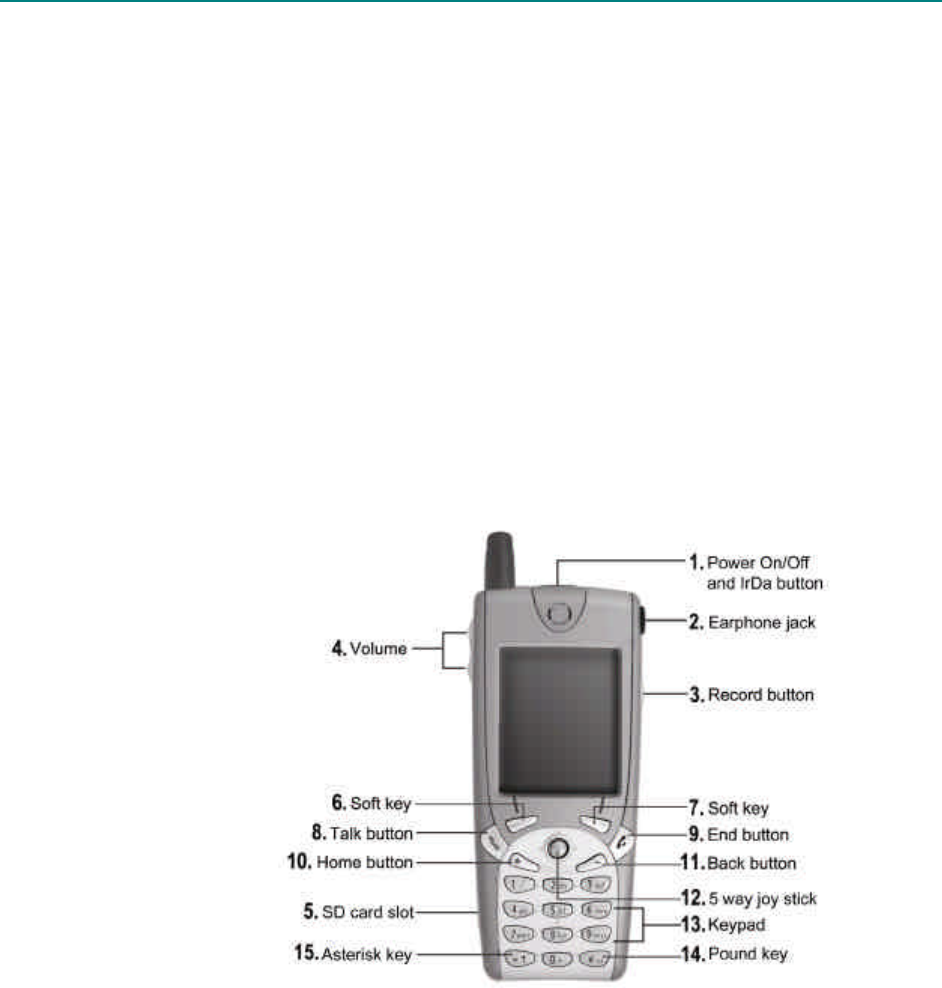
Windows® Powered Smartphone User’s Guide
1
Chapter 1 Getting Started
Congratulations on the purchase of your new Windows® Powered
Smartphone! This chapter will help you set up your Smartphone, charge the
Smartphone’s batteries, and familiarize yourself with the different
components of your Smartphone. You will also find information about
installing Microsoft® ActiveSync®, and where you can find additional help for
using your Smartphone.
Getting to know your Smartphone
Front View
Figure 1 Front view of Smartphone
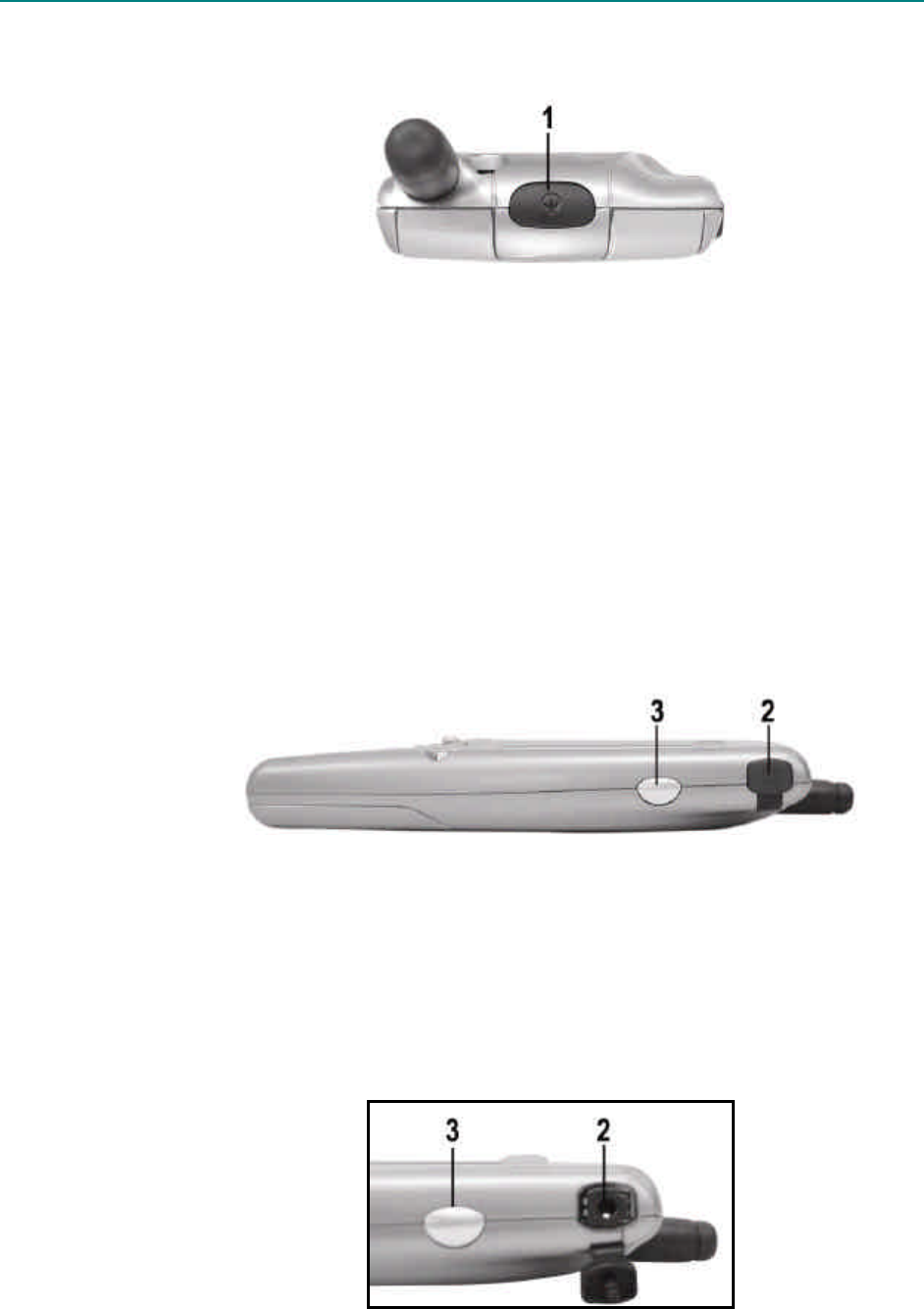
Windows® Powered Smartphone User’s Guide
2
Top View
Figure 2 Top view of Smartphone
1. Power On/Off and IrDa button
§ Pressing the Power button turns the Smartphone on/off.
§ When the Smartphone is on, pressing the Power button accesses the Quick
List.
§ Pressing and holding the Power button turns the Smartphone off.
§ This button also provides the IrDA connection and active sync and
wireless data-transferring interface.
Right Side View
Figure 3 Right side view of Smartphone
2. Earphone jack
§ The audio component of the Smartphone.
3. Record button
§ Records notes and processes voice tags.
Figure 4 Record button of Smartphone
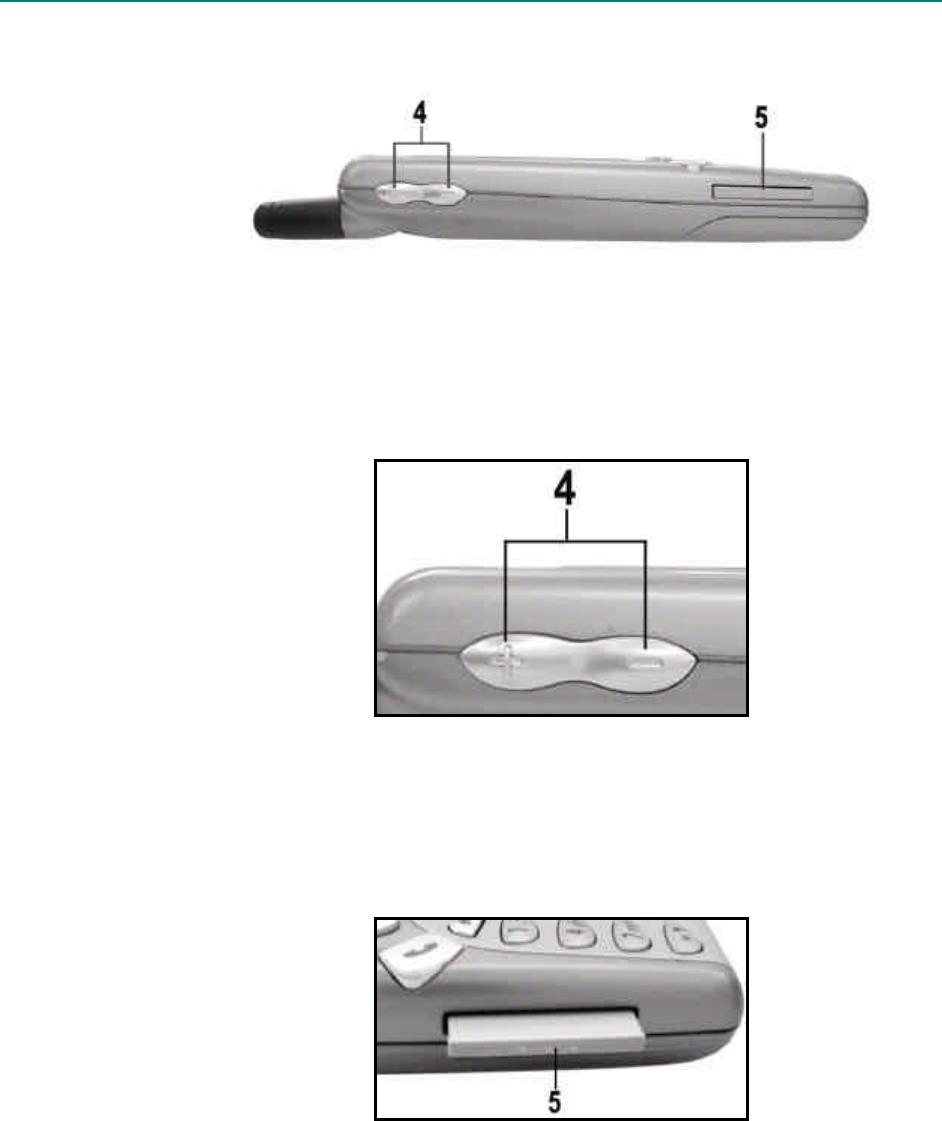
Getting Started
3
Left Side View
Figure 5 Left side view of Smartphone
4. Volume
§ Controls the volume of the Earphone and headset.
§ Press “+” to increase and “-“ to decrease the volume.
Figure 6 Adjust Volume buttons
5. SD card slot
§ You can store the images recorded by Digital Camera in the SD card and
transfer all images to the PC with a card reader.
Figure 7 SD card slot
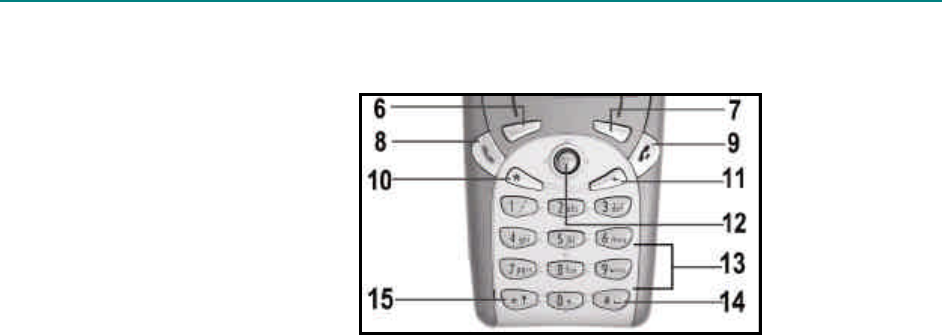
Windows® Powered Smartphone User’s Guide
4
Smartphone Buttons
Figure 8 Smartphone buttons
6. Soft key
§ Performs the command shown on the screen immediately above the key.
7. Soft key
§ Performs the command shown on the screen immediately above the key.
8. Talk button
§ Dials a phone number you entered using the keypad.
§ Dials a phone number you selected from the Call History list.
§ Answers an incoming call.
§ Places a call on hold to answer a second incoming call (call waiting).
§ Changes between an active call and a call that is on hold.
9. End button
§ Ends active data calls at any time.
§ Ends a call when one party is on the line, and ends the active call when
multiple parties are connected.
10. Home button
§ Displays the Home screen.
11. Back button
§ Navigates to the previous screen, or backspaces over one or more
characters when you are in a text field.
12. 5 way joy stick/Enter button
§ Move the selection focus up, down, right, or left and move the cursor left
or right in the text fields.
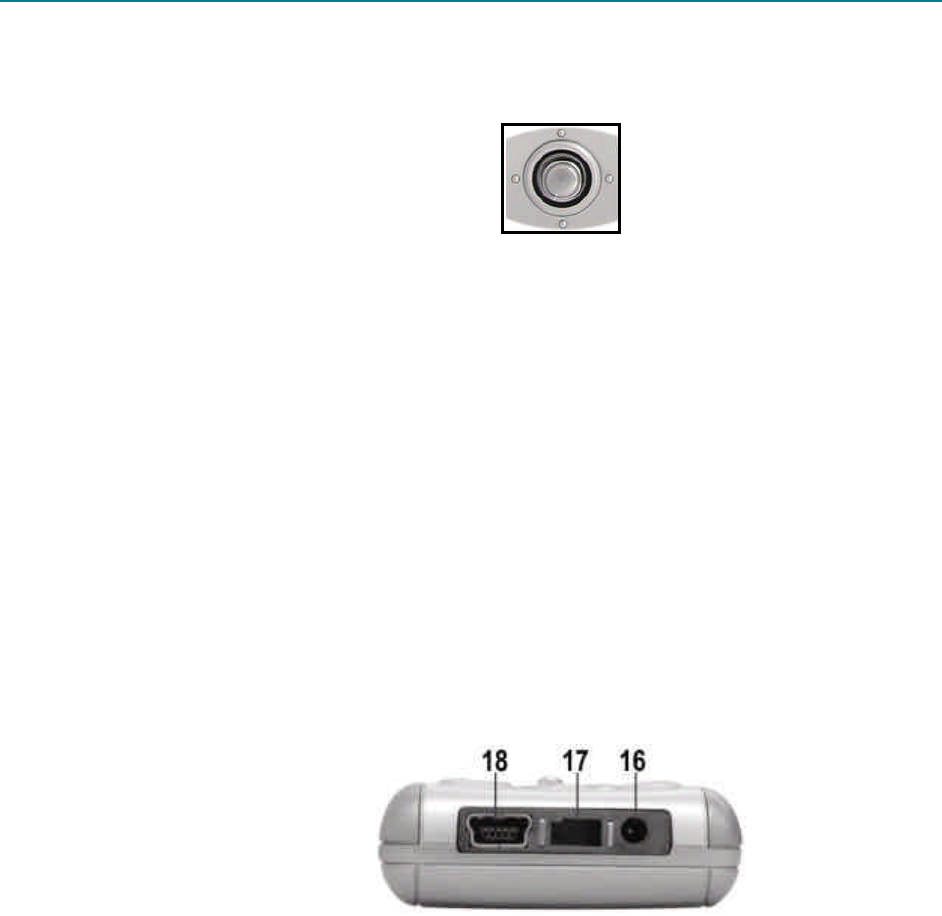
Getting Started
5
§ You can press down the round button in the center to confirm your
selection much like pressing "Enter" on a keyboard.
Figure 9 5 way joy stick/Enter button of Smartphone
13. Keypad
Used to enter numbers and characters.
14. Pound key (#)
Pressing and holding the Pound key displays a list of symbols.
15. Asterisk key (*)
Pressing the Asterisk key changes between upper and lower case in text input
mode. Pressing and holding the Asterisk key changes between text and
numeric input modes.
Bottom View
Figure 10 Bottom view of Smartphone
16. Power jack
Connect to an AC adapter.
17. Reserved empty socket
This reserved empty socket is future additional expansion use.
18. Mini USB connector
Connect to your computer and exchange or update data by using USB cable.
(Please use the supplied USB cable in the package.)
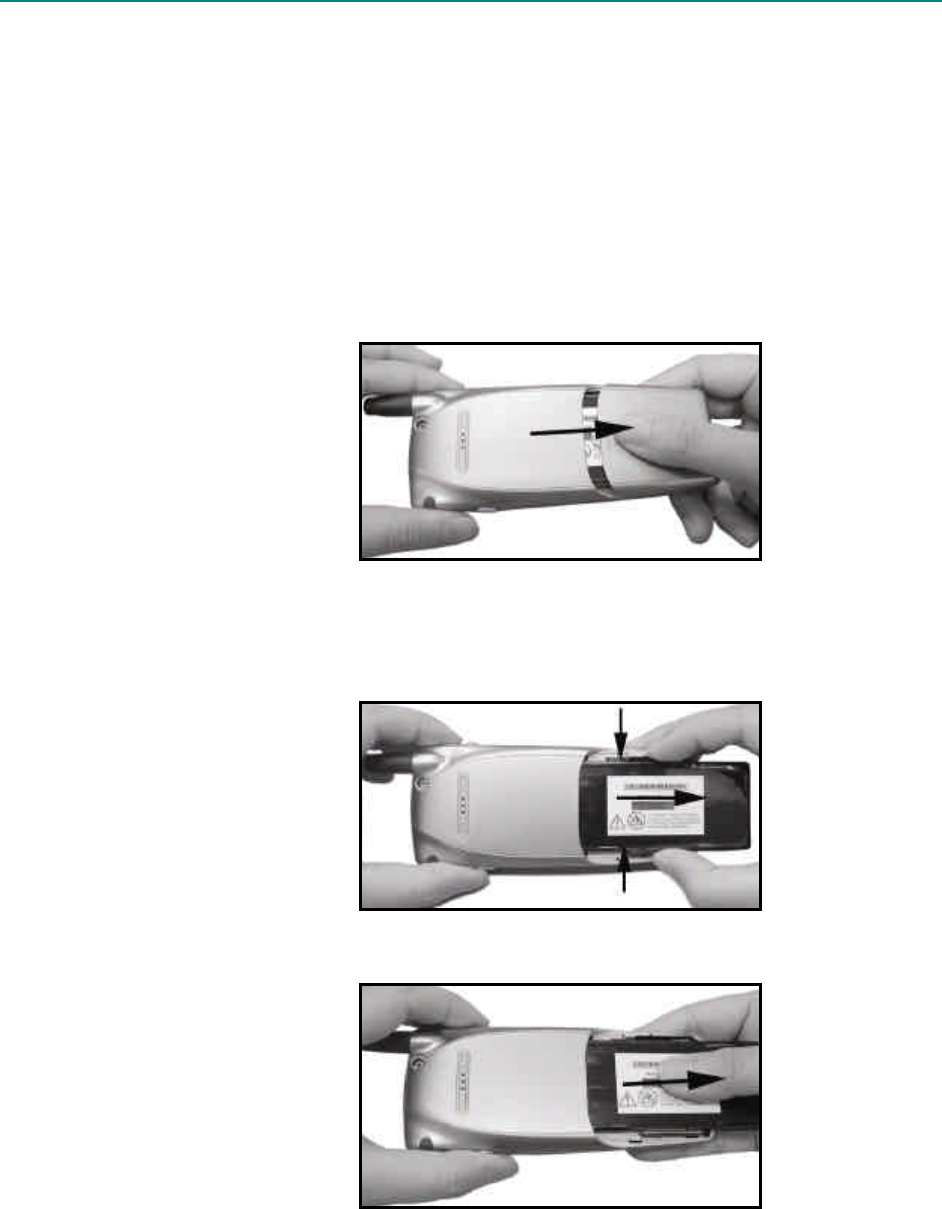
Windows® Powered Smartphone User’s Guide
6
Inserting/Removing the battery
1. Make sure your phone is switched off. You can do so by holding down the
Power button until the phone is powered off. Or you can select the
"Power Off" option from "Quick List" by pressing and releasing the
Power button.
2. Remove the lid at the back of the phone by pressing down and sliding it
away from the phone.
Figure 11 Remove the lid of Smartphone
3. Remove the battery by holding down the latches at both sides of the
battery and pull it out of its slot.
Figure 12 Remove the battery
Figure 13 Remove the battery
4. Slide the battery into its slot and put the lid back on.
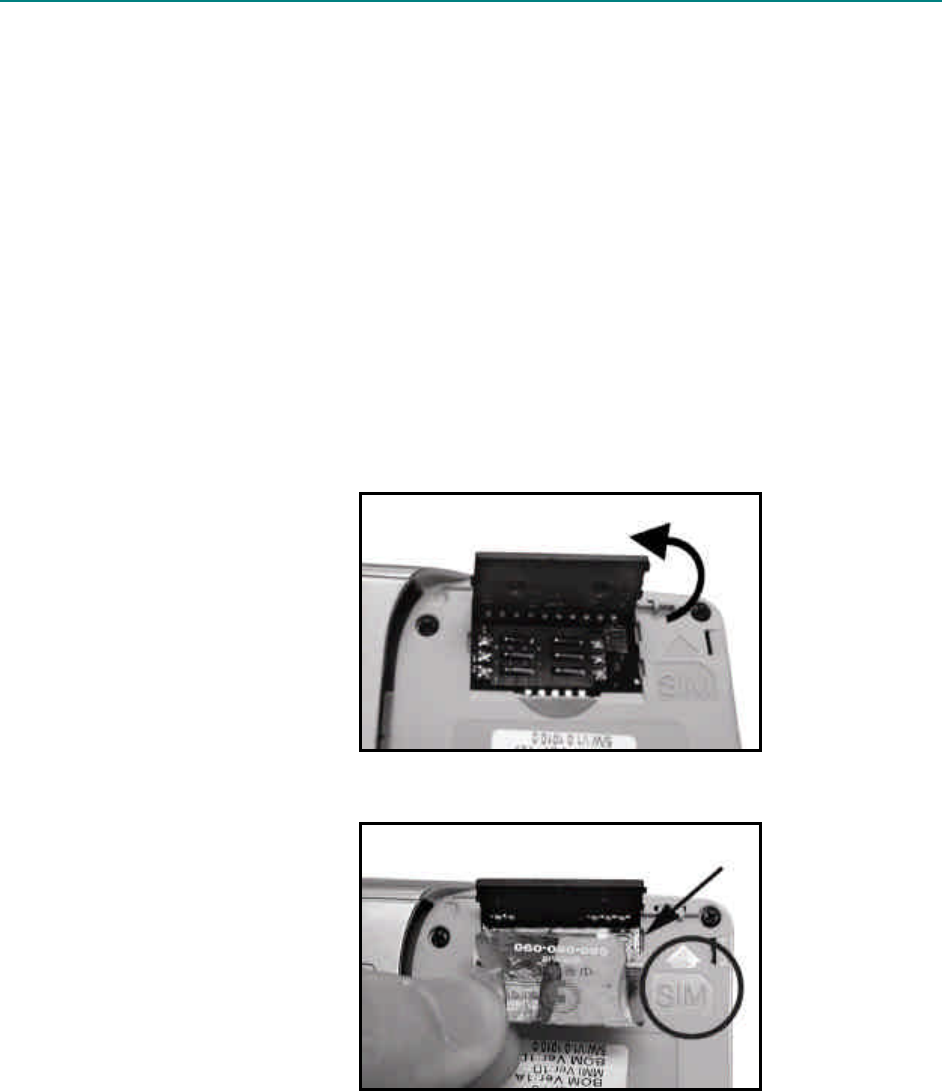
Getting Started
7
Inserting/Removing the SIM card
Inserting the SIM card
When you subscribe to a cellular network, you are provided with a SIM card.
You must insert your SIM card for the phone to work.
1. Make sure your phone is switched off. You can do so by holding down the
Power button until the phone is powered off. Or you can select the
"Power Off" option from "Quick List" by pressing and releasing the
Power button.
2. Remove the battery.
3. Open the SIM card cover. Insert the SIM card and position it
appropriately. Please abide to the direction marked on the phone and next
to the SIM card cover to avoid damages to the SIM card.
Figure 14 Open the SIM card cover
Figure 15 Insert the SIM card

Windows® Powered Smartphone User’s Guide
8
4. Close the SIM card cover and slide the cover downwards to lock it.
Figure 16 Close the SIM card cover
5. Slide the battery into its slot and put the lid back on.
Removing the SIM card
To remove the SIM card, reverse the above steps.

Getting Started
9
Charging the battery
A travel adapter is provided with your phone to charge your standard-issued
Li-ion battery.
1. Connect the battery charger to your phone by inserting the plug into the
matching socket located at the rear end of the phone.
2. Disconnect the battery charger when fully charged.
§ The phone can be used while the battery is charging.
§ Before using a new battery for the first time, you must fully charge it.
Do not force the plug into the socket to avoid damages to the phone and/or the
adaptor.

Windows® Powered Smartphone User’s Guide
10
Status indicators
Status indicators are displayed at the top of the Smartphone’s display. The
following table lists common status indicators and their meanings.
Indicator Meaning
New e-mail
New voice mail
New instant message
Voice call active
Data call active
Call forwarding
Call on hold
Missed call
Line 1
Line 2
Battery level
Low battery
Battery charging
No battery
Signal strength
No signal
GPRS available
GPRS in use
Roaming
Sync error
Radio off
Ringer off
Multipress text input mode, lowercase
Multipress text input mode, uppercase
Multipress text input mode, caps lock
T9 text input mode, lowercase
T9 text input mode, uppercase

Getting Started
11
Indicator Meaning
T9 text input mode, caps lock
Numeric input mode
Synchronizing with ActiveSync
You can use Microsoft® ActiveSync® technology to synchronize information
on your desktop computer and/or a Microsoft® Exchange Server with the
information on the Smartphone. ActiveSync compares the information on the
Smartphone with the information on the desktop computer and/or the server
and updates all locations, keeping you up-to-date with the most recent
information.
Note: You can synchronize information directly with a Microsoft Exchange
Server if your company is running Microsoft® Mobile Information Server
2002 or later.
Installing ActiveSync
For instructions on installing ActiveSync on your desktop computer, see the
Smartphone Quick Start Card. ActiveSync is already installed on the Smartphone.
Note: Make sure to install ActiveSync on your desktop computer before
connecting the Smartphone to the desktop computer.
After the first synchronization, take a look at Calendar, Contacts, and Tasks
on the Smartphone. You will notice that your information has been copied to
the Smartphone. Disconnect the Smartphone from the desktop computer and
you are ready to go!
For more information about ActiveSync, see Chapter 7, “Synchronizing
Information.”
Where to find information
The following table is a guide to finding information to help you use the
Smartphone.
Information about Source
Making a phone call Smartphone User’s Guide: Chapter
3, “Phone Calls.”
Programs on the Smartphone Smartphone User’s Guide

Windows® Powered Smartphone User’s Guide
12
Information about Source
Additional programs that can be
installed on the Smartphone
Smartphone Companion CD
Connecting to and synchronizing with a
desktop computer and/or a Microsoft
Exchange Server
Smartphone Quick Start Card or
ActiveSync Help on your desktop
computer
Text entry Smartphone User’s Guide or
Smartphone Quick Reference Card
Smartphone How-To information on the
Web
Smartphone Pocket Internet
Explorer Favorites list
Last-minute updates and detailed
technical information
Readme files, located in the
Microsoft ActiveSync folder on the
desktop computer.
Up-to-date information on your
Smartphone
http://www.microsoft.com/mobile

Windows® Powered Smartphone User’s Guide
13
Chapter 2 The Basics
This chapter explains basic information about using the Smartphone, such as
navigating around the Smartphone, entering text and numbers on the
Smartphone, and securing the Smartphone.
Navigation methods
The following information describes the different methods for navigating
around the Smartphone so you can accomplish tasks quickly and easily.
Using the Direction keys
The Direction keys are used to navigate horizontally and vertically on the
screen to move the selection focus, so you can select the item you want. When
you see instructional text about selecting an item, use the appropriate
Direction key to make your selection.
The following table shows the four different actions you can perform with the
Direction keys, and how they help you navigate on the screen.
Direction key action Navigation
Press Up Moves the selection focus upward on the screen.
Press Down Moves the selection focus downward on the
screen.
Press Right Moves the selection focus forward on the screen,
or moves the cursor forward through characters in
a text field.
Press Left Moves the selection focus backward on the screen,
or moves the cursor backward through characters
in a text field, without deleting characters.
Using the Action button
The Action button confirms your selection. You can think of the Action
button as the “Do It” button. In some cases, confirming your selection will
take you to a program or setting.
Using the Home button
The Home button takes you to the Home screen.
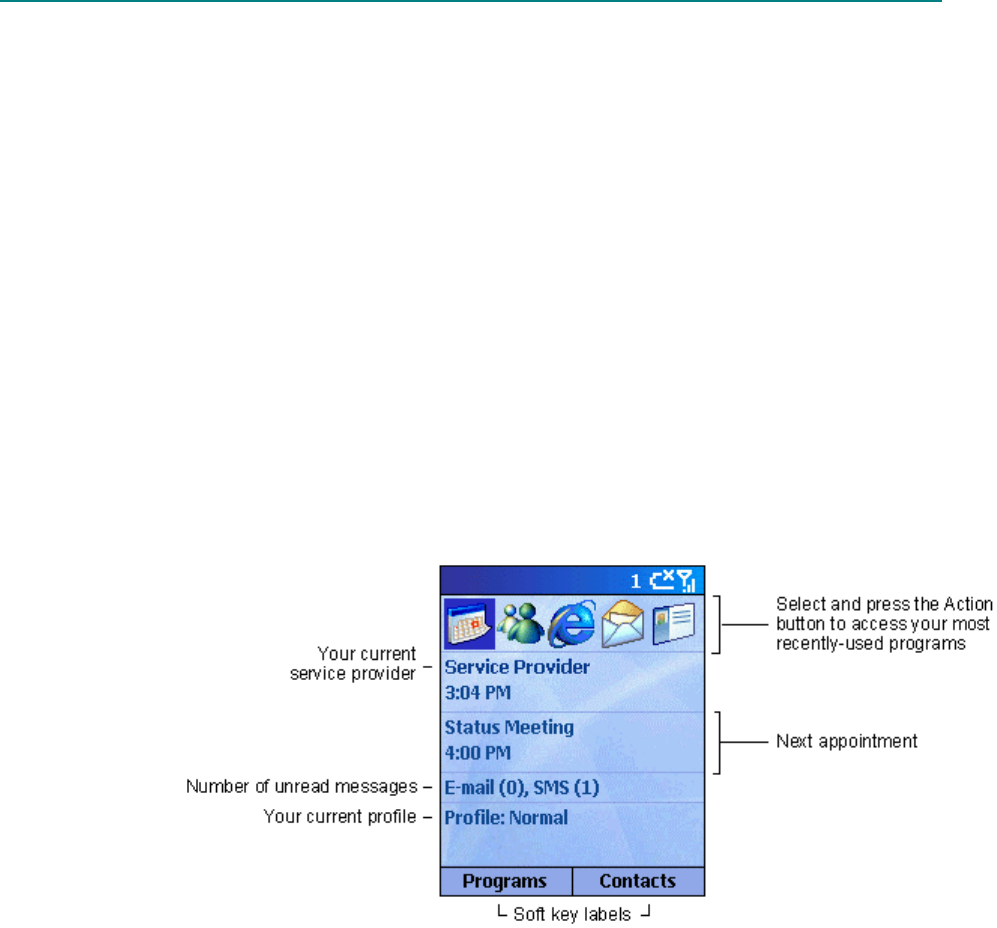
Windows® Powered Smartphone User’s Guide
14
Using the Home screen
§ The Home screen is your starting place for most tasks. You can easily
navigate to any program or setting on the Smartphone from this screen.
The top of the Home screen displays the five programs you have most
recently used. Just select a program and press the Action button to open
the program. The Home screen also displays the current time, your next
appointment, the number of messages in Inbox, and your current profile.
§ Selecting your next appointment and pressing the Action button opens
Calendar so you can see all of your appointments for the day. To view
Inbox, just select the e-mail status showing the number of messages you
have, and press the Action button. To view Contacts, press the Contacts
soft key.
§ The Home screen automatically displays when you turn the Smartphone
on or leave the Smartphone idle when it is on, but you can navigate to it at
any time by pressing the Home button.
Figure 17 The Home screen
4 To access the Home screen
§ Press the Home button.
Navigation options from the Home screen
§ Select a recently-used program at the top of the screen, and then press the
Action button to open the program.
§ Select an item in the center of the Home screen, such as your next
appointment, your e-mail/SMS information, or your profile type, and then
press the Action button to open the program or access the settings
associated with the item selected.
§ Press the Programs soft key to display the list of programs available on the
Smartphone, select a program, and then press the Action button.
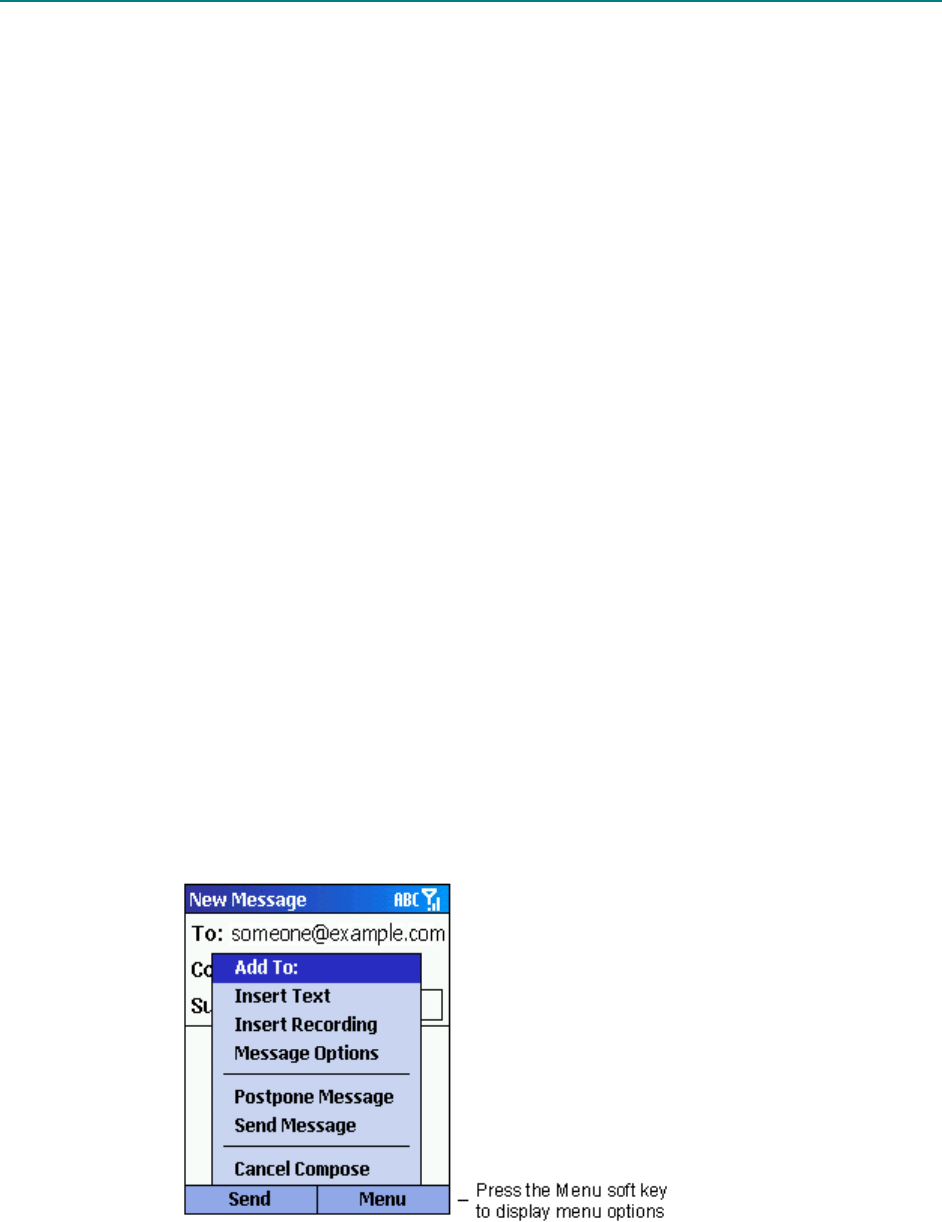
Getting Started
15
§ Press the Contacts soft key to display the Contacts list, select a contact,
and then press the Action button.
Using the Back button
Pressing the Back button navigates to the previous screen, or moves the cursor
back to delete one or more characters in a text field, similar to pressing
“Backspace” on a keyboard.
4 To backspace and remove one character in a text field
§ Press the Back button.
4 To backspace and remove multiple characters in a text field
§ Press and hold the Back button.
Using soft keys
There are two soft keys on the Smartphone, located directly below the display
screen. Each soft key performs the command displayed immediately above it
on the screen, making it easy to navigate around the Smartphone and to
perform common commands.
Using menus
On many screens, the right soft key is labeled Menu. The Menu soft key
displays a list of menu options that are relevant to the screen you are viewing.
Selecting a menu option will either perform the command or take you to
another part of the user interface where you can perform the command.
Figure 18 New Message menu screen displayed

Windows® Powered Smartphone User’s Guide
16
4 To access menu options
1. Press the Menu soft key on any screen where it is displayed.
2. Select a menu option and press the Action button.
Tip: Pressing Up moves the selection focus to the bottom of the menu.
Using the Programs list
The Smartphone comes pre-installed with many programs that you can start
using. To install additional programs on the Smartphone, refer to the
Smartphone Companion CD that came with the Smartphone. If the Smartphone
provides a SIM toolkit to access programs on the SIM card, the toolkit is
added to Programs.
4 To navigate to a program
1. On the Home screen, press the Programs soft key.
2. Select a program and press the Action button.
Using numbers
You can also use numbers to navigate quickly to programs and settings on the
Smartphone. Just press the number on the keypad that corresponds to the
number shown next to the program or setting you want.
For example, in Programs, press 3 on the keypad to open Calendar.
Tip: You can also use numbers to select menu options by pressing the
number that corresponds to the menu option in top-down order. For example,
if you want to select Filter in the list of Contacts menu options, you can press
4 on the keypad because the Filter option is fourth in the list.
Using the Quick List
The Quick List displays a list of commands, such as locking the Smartphone,
locking the Smartphone’s keypad, turning off the radio, and the list of
available profile types.
4 To access the Quick List
§ Press the Power button.
Entering text and numbers on your Smartphone
You can enter text and numbers on the Smartphone using the keypad. The
Smartphone supports three input modes for entering text and numbers:
Multipress, T9, and Numeric. The Multipress and T9 modes are used for

Getting Started
17
entering text, and the Numeric mode is used for entering numbers. When you
select a field that requires text or numeric entry, the Smartphone will
automatically default to the appropriate input mode. The status indicator on
the top of the display shows the input mode you are currently using.
4 To change input modes
§ Press and hold the Asterisk (*) key until the status indicator for the input
mode you want is shown on the top of the display.
The following table shows the complete list of input mode status indicators.
Indicator Mode
Multipress text input mode, lowercase
Multipress text input mode, uppercase
Multipress text input mode, caps lock
T9 text input mode, lowercase
T9 text input mode, uppercase
T9 text input mode, caps lock
Numeric input mode
Entering text in Multipress mode
When you are in Multipress mode, you can enter a letter by pressing the
number key on which the letter appears. To enter the first letter on the number
key, press the key once. To enter the second letter, press the key twice, and so
on. The letter entered most recently is underlined until you have completed
the keypresses for the letter and moved on to the next letter.
For example:
§ To enter the letter “s,” press 7777.
§ To enter the word “hat,” press 44, 2, 8.
When you enter letters that are on the same number key, you must pause after
entering the first letter and wait until the underline disappears before entering
the next letter so that your Smartphone can process the first letter. This pause
is called the Multipress time out, and you can adjust the length of the pause
between keypresses.
For example:
§ To enter the word “cat,” press 222, pause, press 2, and then press 8.
4 To change the Multipress time out
1. On the Home screen, press the Programs soft key, select Settings, and
then select Accessibility.

Windows® Powered Smartphone User’s Guide
18
2. Under Multipress time out, select the time interval you want for the pause
between keypresses, and press the Done soft key.
4 To enter punctuation in Multipress mode
§ Press 1 repetitively to scroll through common punctuation.
Entering text in T9 mode
When you are in T9 mode, just press the number keys that contain the letters
you want to form a word. T9 will then analyze your keypresses and attempt to
complete the word.
For example:
§ To enter the word “shoe”, press 7, 4, 6, 3.
4 To enter text using T9 mode
3. Press and hold the Asterisk (*) key until the T9 indicator appears on the
top of the display.
4. Enter the numerical sequence that represents the word you want to enter.
5. Press the Pound (#) key to accept the word and enter a space after it, or
press 0 to scroll through the available words.
6. If you do not see the correct word, erase the word, and then press and hold
the Asterisk (*) key to change to Multipress mode, and manually enter
the word.
Having trouble entering a word in T9 mode?
T9 cannot always find the word you want in the T9 dictionary; in these cases,
change to Multipress mode. After you have entered the word in Multipress
mode, the word will be added to the T9 dictionary.
4 To enter punctuation in T9 mode
§ Press 1, then 0 to scroll through common punctuation.
Entering numbers in Numeric mode
When you are in Numeric mode, just press the number(s) you want to enter on
the keypad. If a field permits a numerical entry only, such as the Work phone
field in Contacts, the input mode will automatically default to Numeric mode.
Miscellaneous input tasks
4 To enter a space
§ In Multipress or T9 mode, press the Pound (#) key on the keypad.

Getting Started
19
4 To start a new line
§ Press the Action button.
4 To change between uppercase and lowercase in text mode
§ Press the Asterisk (*) key to change between uppercase and lowercase.
Tip: When you are in text mode, the first letter of a sentence is
automatically capitalized.
4 To lock caps
§ Press the Asterisk (*) key twice. Press the Asterisk (*) key again to return
to lowercase.
4 To enter a symbol
§ Press and hold the Pound (#) key, select a symbol, and then press the
Done soft key.
4 To enter a number, an asterisk (*), or a pound sign (#)
§ Change to Numeric mode, and press the corresponding key on the keypad.
4 To delete characters
1. Press the Back button to backspace over a single character.
2. Press and hold the Back button to backspace and delete an entire text
field.
4 To enter the plus (+) sign for international calls
§ Press and hold 0.
Securing your Smartphone
You can customize the level of security you want to have on the Smartphone
by locking the keypad, the entire Smartphone, or the SIM card.
Locking the keypad
The keypad lock turns off the keypad functionality. This is a helpful feature if,
for example, the Smartphone is turned on and in your pocket, and you want to
prevent accidental keypresses.
4 To lock your keypad
§ On the Home screen, press and hold the End button. The left soft key will
display Unlock, indicating that the Smartphone is locked.
4 To unlock the keypad
§ On the Home screen, press the Unlock soft key, and press the Pound (#)
key.

Windows® Powered Smartphone User’s Guide
20
Note: You can still receive calls and make emergency calls when the keypad
is locked.
Locking the Smartphone
Locking the Smartphone prevents access to personal data. When you enable
this feature, the Smartphone will automatically lock after a specified time of
inactivity. A screen will be displayed requiring your Smartphone lock
password before access is granted.
Note: You can still receive calls and make emergency calls when the
Smartphone is locked.
4 To lock the Smartphone
1. Press the Power button to display the Quick List, select Device lock, and
then press the OK soft key.
2. Under Lock phone after, select the amount of time the Smartphone is
inactive before the Smartphone automatically locks.
3. Under Password, enter the password you want to use to access the
Smartphone when it is locked.
4. Under Confirm password, enter the password again, and press the Done
soft key.
Note: After you have selected the time delay and created a password, you
can then quickly lock your Smartphone from the Quick List, without having to
view these settings.
4 To unlock your Smartphone
§ Press the Unlock soft key, enter your password, and then press the Unlock
soft key again.
4 To turn off phone lock
§ On the Home screen, press the Programs soft key, select Settings, select
More, select Security, select Disable Phone Lock, and then press the
Done soft key.
Locking the Subscriber Identity Module (SIM) card
Locking the SIM card prevents you and others from using the Smartphone that
contains the SIM card until the correct password is entered. You can still
make emergency calls when the SIM card is locked.

Getting Started
21
4 To lock the SIM card
1. On the Home screen, press the Programs soft key, select Settings, select
More, select Security, select Enable SIM Lock, and then press the Done
soft key.
2. Enter your PIN1 password, and press the Done soft key.
4 To unlock the SIM card
1. On the Home screen, press Programs, select Settings, select More, select
Security, select Disable SIM Lock, and then press the Action button.
2. Enter your PIN1 password, and press the Done soft key.

Windows® Powered Smartphone User’s Guide
22
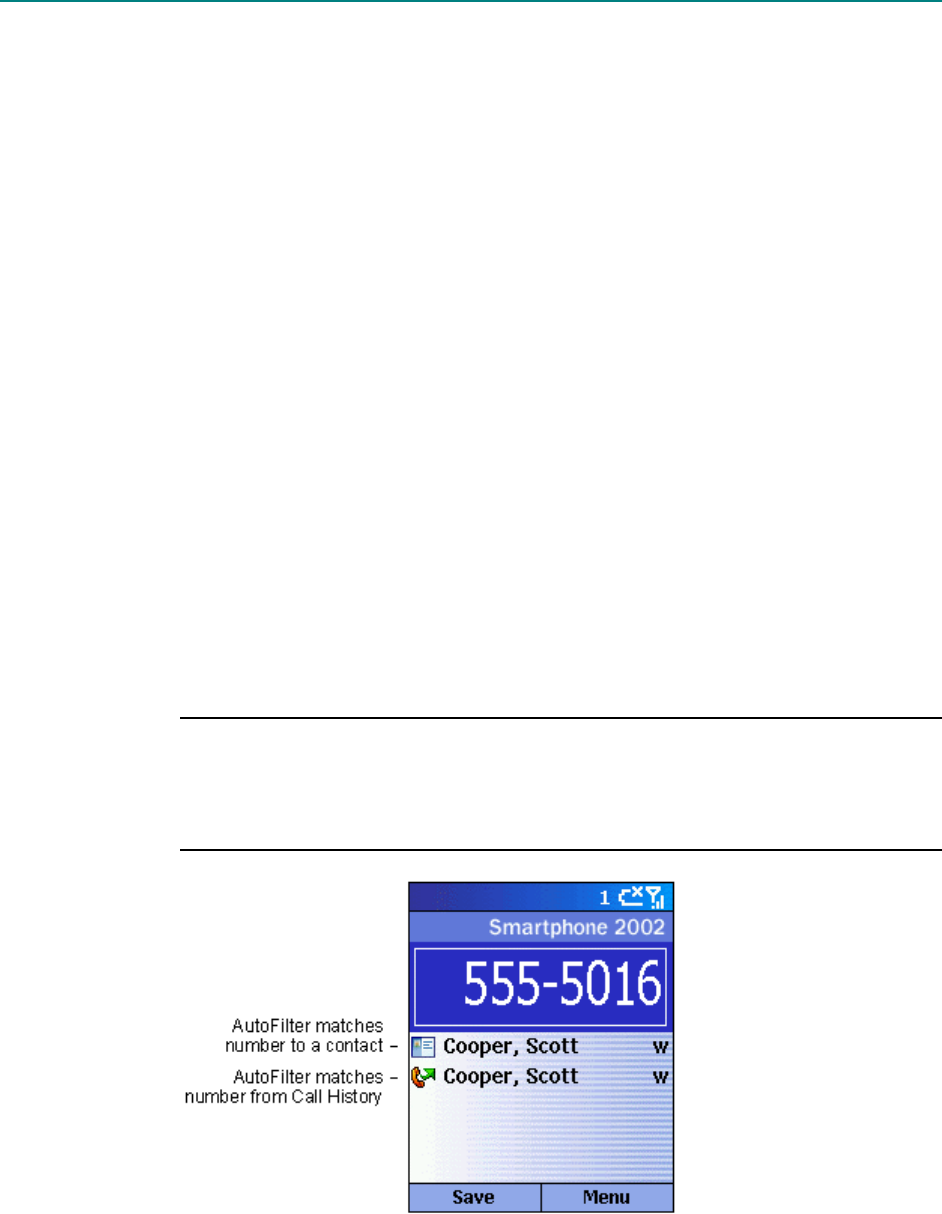
Windows® Powered Smartphone User’s Guide
23
Chapter 3 Phone Calls
This chapter explains how to make and receive phone calls, view Call History,
and create shortcuts to help you manage calls more efficiently.
Making a call
There are several ways to make a call. The easiest way is to simply dial a
phone number from the Home screen.
4 To make a call
§ On the Home screen, press the numbers on the keypad to enter the phone
number, and then press the Talk button.
4 To make a call by entering a contact name
1. On the Home screen, press the keys on the keypad to spell the contact
name.
2. When you see the contact name displayed, select it, and press the Talk
button.
Tip: As you enter a phone number or contact name, the Smartphone
searches Contacts, Call History, Speed Dial lists, and the Subscriber Identity
Module (SIM) card to find a matching name and/or number. When you see the
name of the person to call listed, select it, and press the Talk button.
Figure 19 Call Progress screen for making a call

Windows® Powered Smartphone User’s Guide
24
Making a call from Contacts
To call someone from the Contacts list, just select the person’s name, and
press the Talk button.
If you have more than one phone number for a contact, such as a Work phone
number, a Home phone number, and a Fax number, the Work phone number
is set as the default number. Pressing the Talk button will always dial the
default number, but you can change the default number at any time.
4 To make a call by contact name
1. On the Home screen, press the Programs soft key, select Contacts, and
then press the Action button.
2. Select the contact name to call, and press the Talk button.
Tip: If you have a long list of contacts and you don’t see the contact you
want on the screen, you can enter the first few letters of the contact’s name,
and the Smartphone will search through the entire Contacts list and display the
name.
4 To change the default number for a contact
1. On the Home screen, press the Programs soft key, select Contacts, and
then press the Action button.
2. Select the contact, and press Left or Right to change the default number.
3. For example: If you change “w” to “m,” the default number changes from
Work phone (w) to Mobile phone (m).
Note: For more information about contact list abbreviations, see Chapter 6,
“Contacts, Calendar, and Tasks.”
4 To make a call from an open contact
1. On the Home screen, press the Programs soft key, select Contacts, and
then press the Action button.
2. Select the contact to call, and press the Action button.
3. Select the number you want to call, and press the Talk button.
Making a call using a recently-dialed number
You can display a list of phone numbers you have recently dialed and choose
a name or number from the list to call the person again.
4 To make a call using a recently-dialed phone number
1. On the Home screen, press the Talk button to display a list of recently-
dialed phone numbers.

Phone Calls
25
2. Select the number or name for the person to call, and press the Talk
button again.
Making a call from the Call History list
The Call History list displays the last 25 calls you made, received, and missed.
Choose a name or number to call someone from the list.
4 To make a call from the Call History list
1. On the Home screen, press the Programs soft key, select Call History,
and then press the Action button.
2. Select the number or entry for the person to call, and press the Talk
button.
Making a call from a hyperlink
When you see an underlined phone number presented as a hyperlink in an e-
mail message, just select the hyperlink phone number, and press the Action
button to make the call.
Making emergency calls
Calls to emergency service numbers can be made under any circumstances,
even if you have locked the SIM card and/or the Smartphone.
4 To place an emergency call
§ On the Home screen, dial the emergency number appropriate for your
location, and press the Talk button.
Having problems making a call?
Check to make sure that the Smartphone contains a valid SIM card and that
the Smartphone is turned on, unlocked, and in the service area of the selected
service provider’s network.
Receiving a call
You can answer a call by pressing the Talk button or the Accept soft key. If
you don’t want to take the call, press the Reject soft key.
Tip: There may be situations where you want to immediately silence the
ring of an incoming call. Simply press the Volume control, and then proceed
to answer the call.
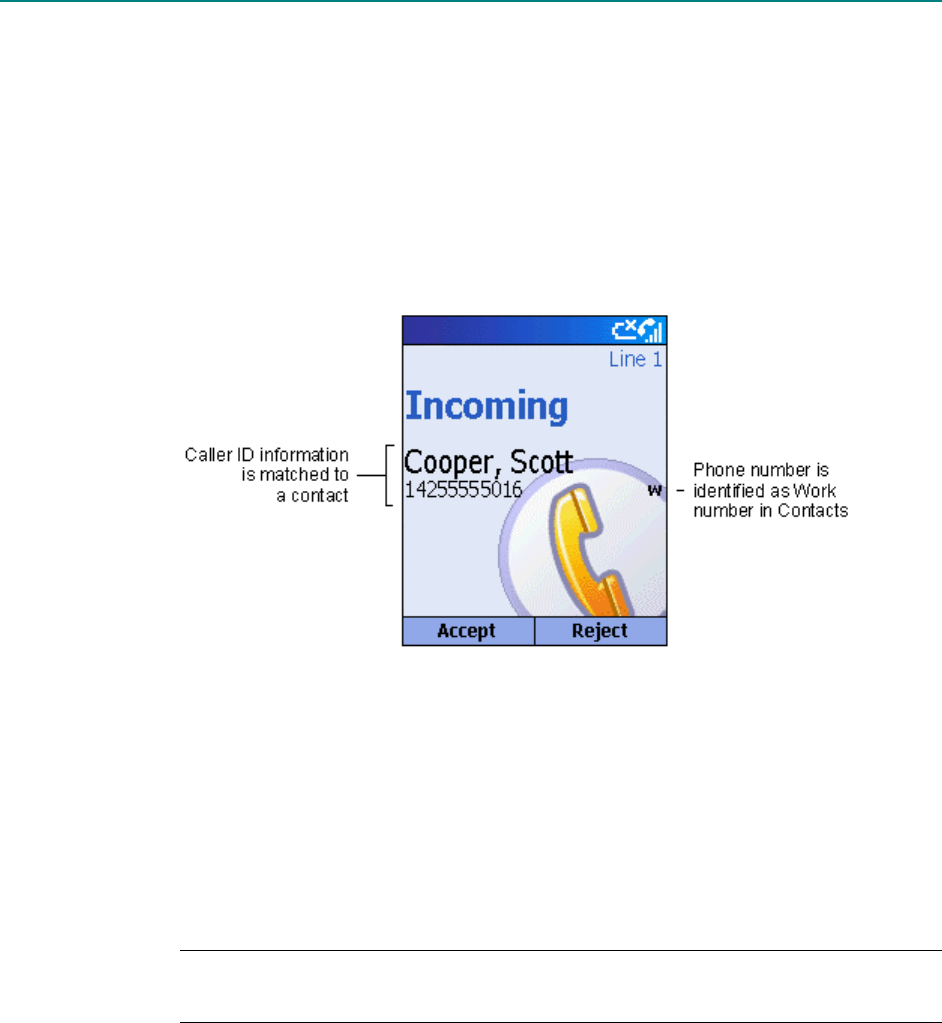
Windows® Powered Smartphone User’s Guide
26
4 To answer an incoming call
§ Press the Talk button or the Accept soft key.
4 To reject an incoming call
§ Press the End button or the Reject soft key.
When you receive a call, the name and number of the caller are displayed on
the screen. If the name of the caller is not in your Contacts list, only the
caller’s phone number will be displayed.
Figure 20 Call Progress screen for receiving a call
4 To answer a second call using Call Waiting
§ If you are already talking on the Smartphone when you receive a call,
press the Accept soft key or the Talk button to place the first call on hold,
and answer the second call.
§ If you want to end the first call before answering the incoming call, press
the End button, and then press the Accept soft key or the Talk button to
accept the incoming call.
Note: Call Waiting is available only if you have subscribed to this service.
Check with your service provider.
4 To reject a Call Waiting call
§ If you are already talking on the Smartphone when you receive a call and
you don’t want to answer it, press the Reject soft key. This will keep your
current call in progress, but will reject the Call Waiting call.

Phone Calls
27
In-call options
While a call is in progress, you can press the Menu soft key to access menu
options for common tasks.
The following table shows the menu options available when a call is in
progress. Some of these options are available only when multiple calls are in
progress or during a conference call.
Menu Option Function
End Disconnects the call.
Hold Places the active call on hold.
Unhold Activates the call on hold.
Swap Changes between two calls.
Save Contact Creates a contact for the caller.
Conference Joins together all existing calls, if you have subscribed to
this service.
Private Breaks one call out of a conference and makes this call
active while the rest of the conference is on hold.
Speakerphone Increases the volume of the earphone.
Mute Mutes the microphone for the active call. The other party
will not hear anything you say, but you can still hear the
other party.
Unmute Turns the microphone back on for the active call.
Miscellaneous call tasks
4 To place a call on hold
§ Press the Hold soft key.
4 To change between two calls
§ Press the Swap soft key.
4 To end a call
§ Press the End button to disconnect.
4 To redial the last number called
§ On the Home screen, press the Talk button twice.
4 To listen to a voice-mail message
1. On the Home screen, press and hold 1 to automatically call the voice-mail
system.

Windows® Powered Smartphone User’s Guide
28
Note: You can also access voice-mail messages from Inbox. Just select the
voice-mail message, and press the Voice Mail soft key or the Talk button to
call the voice-mail system.
2. On the Home screen, press the Programs soft key. Select Inbox/SMS,
and press the Action button.
3. Select the voice-mail message and press the Voice Mail soft key or the
Talk button. Your voice mail system is then called.
Reviewing your calls
Using Call History and Call Timers, you can view information about phone
calls you have made and received, such as who has called you recently and
how much time you have spent on the Smartphone.
Call History
Call History displays the last 25 calls you have made, received, and missed.
Each entry in Call History contains the start time of the call, the duration, the
caller’s name, if available, and the caller’s number. The oldest calls are
automatically deleted from the list to make room for the newest calls.
4 To view Call History
§ On the Home screen, press Programs, select Call History, and then press
the Action button.
Tip: You can filter Missed Calls, Incoming Calls, and Outgoing Calls.
Press the Menu soft key, select Filter, press the Action button, and select the
filter you want.
4 To view contact information from Call History
§ Select the entry for the contact, press the Menu soft key, select Find
Contact, and then press the Action button.
4 To send an e-mail message from Call History
§ Select the contact, press the Menu soft key, select E-mail, and then press
the Action button.
4 To create a new contact from a number in Call History
§ Select the contact, press the Menu soft key, select Save, and then press the
Action button.
4 To remove an item from Call History
§ Select the item, press the Menu soft key, select Delete, and then press the
Action button.
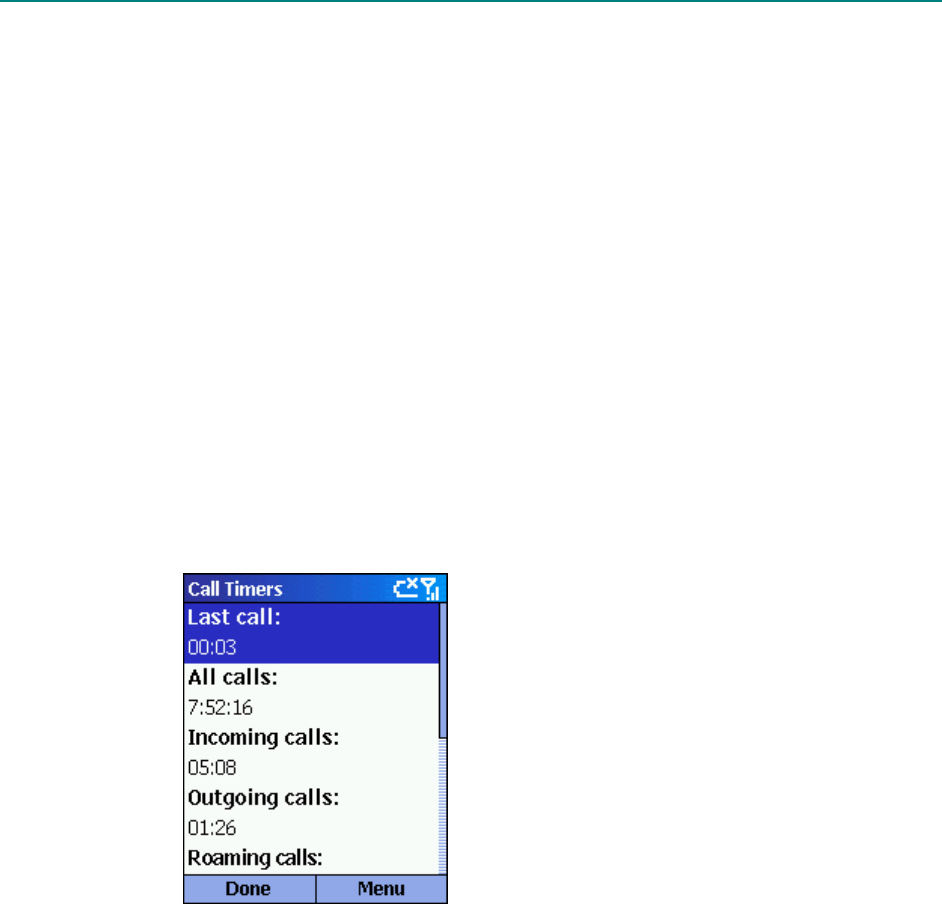
Phone Calls
29
4 To remove all items in Call History
§ Press the Menu soft key, select Delete List, and then press the Action
button.
Call Timers
Call Timers contains detailed information regarding the length of your last
call, the total number of calls made and received, calls by type (incoming,
outgoing, roaming, and data), and a lifetime counter. Call Timers is useful
when you want to keep track of your calling patterns, for example to
determine what type of calling plan to subscribe to or to help you estimate
your monthly billing.
4 To view Call Timers
§ On the Home screen, press the Programs soft key, select Call History,
press the Menu soft key, select View Timers, and then press the Action
button.
Figure 21 Call Timers
Shortcuts
You can create speed dials and voice tags as shortcuts to dial frequently-dialed
phone numbers quickly.
Speed dials
You can create speed dials to dial frequently-dialed phone numbers by simply
pressing and holding one or two keys. You may choose speed dial entries
from 2-99; speed dial 1 is reserved for voice mail access and the number is
configured in your settings.

Windows® Powered Smartphone User’s Guide
30
Note: A speed dial can be created only for a phone number stored in
Contacts.
4 To create a speed dial for a phone number
1. On the Home screen, press the Programs soft key, select Contacts, and
then press the Action button.
2. Open the contact and select the phone number to set up as a speed dial.
3. Press the Menu soft key, select Add Speed Dial, and then press the
Action button.
4. Under Keypad assignment, enter the speed dial number to associate with
the phone number, and press the Done soft key.
Tip: You can also create speed dials for Web addresses and e-mail
addresses that are stored in Contacts.
4 To make a call using a speed dial
§ On the Home screen, press and hold the number on the keypad that you
have assigned as a speed dial for a number. If the keypad assignment is
two digits, press the first digit and press and hold the second digit.
4 To view speed dials you have created
§ On the Home screen, press the Programs soft key, select More, select
Shortcuts, and then press the Action button.
Voice tags
You can record voice tags so that you can dial a phone number simply by
speaking a word.
4 To create a voice tag for a phone number
1. On the Home screen, press the Programs soft key, select Contacts, and
then press the Action button.
2. Open the contact and select the phone number to set up as a voice tag.
3. Press the Menu soft key, select Add Voice Tag, and then press the Action
button.
4. Wait for the audio and visual cue and begin recording your voice tag.
5. When prompted, repeat the voice tag to confirm.
6. If the voice tags match, the Smartphone will display a confirmation and
replay the voice tag.
Note: You can also create voice tags for Web addresses and e-mail addresses
that are stored in Contacts.

Phone Calls
31
4 To make a call using a voice tag
1. On the Home screen, press and hold the Record button.
2. Say the word you have assigned as a voice tag for the phone number you
want to call. The Smartphone will play back the voice tag and then
perform the specified action.
3. If the Smartphone misinterprets the word, press the End button and start
over.
4 To view voice tags you have created
§ On the Home screen, press the Programs soft key, select More, select
Shortcuts, and then press the Action button.
Viewing and deleting shortcuts
Once you have set up speed dials and voice tags, you can view or delete all of
your shortcuts in the Shortcuts list.
4 To view shortcuts
§ On the Home screen, press the Programs soft key, select More, select
Shortcuts, and then press the Action button.
4 To delete shortcuts
1. On the Home screen, press the Programs soft key, select More, select
Shortcuts, and then press the Action button.
2. Select the shortcut to delete, press the Menu soft key, select Delete, and
then press the Action button.
Advanced dialing options
The following information covers advanced dialing options that may be useful
for phone numbers requiring special dialing instructions.
International calls require a country code to be included in the phone number.
The country code is separated from the rest of the number sequence by a plus
(+) sign.
4 To insert an international country code
§ Press and hold 0 until a plus sign (+) appears.
Note: You can insert a plus sign (+) into a contact’s number or dial it directly
from the keypad.
Some international calls require a three-second pause in the dialing sequence
for the call to process successfully.

Windows® Powered Smartphone User’s Guide
32
4 To insert a three-second pause in a dialing sequence
1. On the Home screen, press the Programs soft key, select Contacts, and
then press the Action button.
2. Select the contact, press the Action button, and then select the phone
number to modify.
3. Press the Edit soft key and press Left or Right to move the cursor
between the numbers where you want to insert a three-second pause.
4. Press the Menu soft key, select Insert Pause, and then press the Action
button. The letter “p” will appear in the number to show where the three-
second pause will occur in the dialing sequence.
5. Press the Done soft key.
4 To insert a manual pause in a dialing sequence
There may be phone numbers that require a pause longer than three seconds in
the dialing sequence. For these cases, you can pause as long as you want and
manually continue the dialing sequence using the Talk button.
1. On the Home screen, press the Programs soft key, select Contacts, and
then press the Action button.
2. Select the contact, press the Action button, and then select the phone
number to modify.
3. Press the Edit soft key, and press Left or Right to move the cursor
between the numbers where you want the dialing sequence to pause before
proceeding.
4. Press the Menu soft key, select Insert Wait, and then press the Action
button. The letter “w” will appear in the number to show where the pause
will occur in the dialing sequence.
5. Press the Done soft key.
Note: When you make a call using Insert Wait, press the Talk button to
continue the dialing sequence.
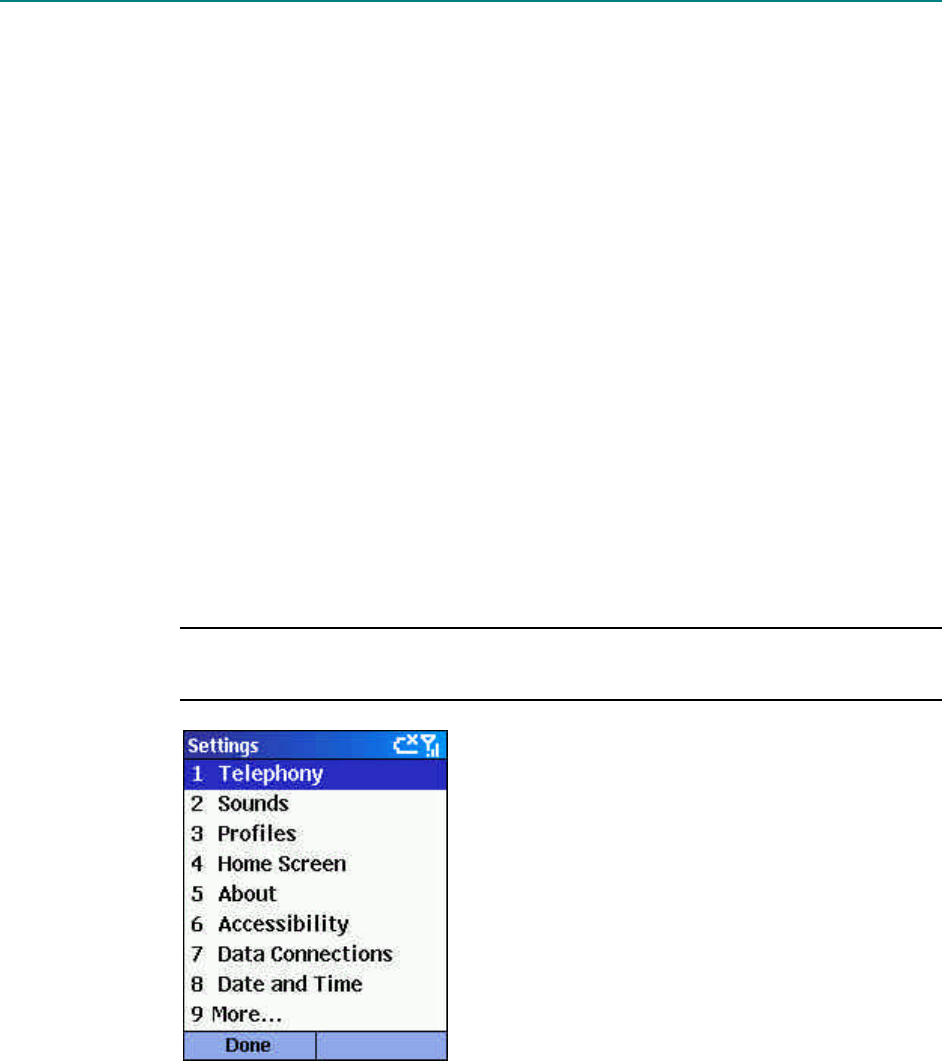
Windows® Powered Smartphone User’s Guide
33
Chapter 4 Settings
This chapter introduces viewing and changing the settings on the Smartphone
and resetting the Smartphone to its original settings.
Viewing and changing settings
You can easily view and change settings to personalize the Smartphone for the
way you work. For example, you can change the sounds or use your own
sounds for ring tones, notifications, and reminders, use your own image for
the Home screen background, set up Call Forwarding and Call Waiting to
manage your calls more efficiently, and more.
4 To view Settings
§ On the Home screen, press the Programs soft key, select Settings, and
then press the Action button.
Note: To view the remaining settings, select More and press the Action
button.
Figure 22 The Settings screen
Telephony
Telephony settings are primarily used to set options for calls you receive, such
as Call Forwarding, Call Waiting, and Caller ID.
4 To view Telephony settings
§ On the Home screen, press the Programs soft key, select Settings, select
Telephony, and then press the Action button.

Windows® Powered Smartphone User’s Guide
34
The following table lists the telephony settings and their functions.
Telephony setting Function
Call Barring Enables you to block incoming and/or outgoing calls.
Call Forwarding Enables you to forward all or selected calls to another
number.
Call Options Enables you to change phone numbers, such as your
voice mail and SMS service center, answer incoming
calls by pressing any key, and other advanced call
options.
Call Waiting Enables you to turn Call Waiting on or off.
Caller ID Enables you to let your identification be known to all
callers, only your contacts, or no callers.
Channels Enables you to configure cell broadcast.
Fixed Dialing Enables you to limit your calling area to one or more
specific phone numbers and/or area codes.
Networks Identifies your current network and changes your
network selection from Automatic to Manual.
Sounds
Sounds settings are used to customize the sounds for ring tones, notifications,
and reminders.
4 To display Sounds settings
§ On the Home screen, press the Programs soft key, select Settings, select
Sounds, and then press the Action button.
4 To use your own sound
1. Go to where the sound file is stored on your desktop computer and copy
the file. The file format must be .wav or .mid.
2. In ActiveSync on your desktop computer, click Explore, double-click
IPSM, double-click Application Data, double-click Sounds, and then
paste the sound file into the Sounds folder.
3. On the Home screen on your Smartphone, press the Programs soft key,
select Settings, select Sounds, and then press the Action button.
4. Select the item to customize, press Left or Right to select the sound, and
then press the Done soft key.
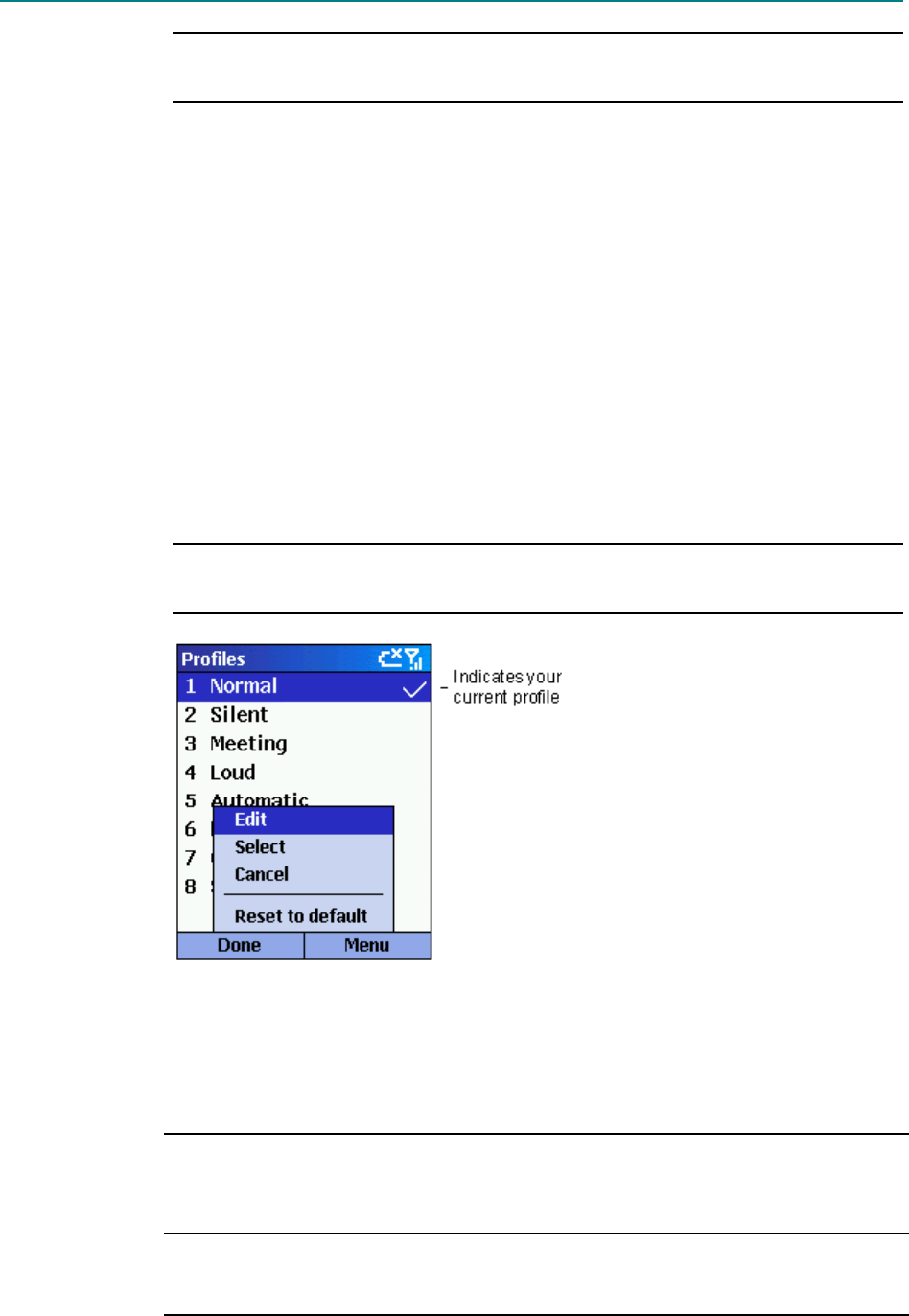
Settings
35
Note: Make sure that the Smartphone is connected to your desktop computer
via USB before you open ActiveSync to paste the sound file.
Profiles
Profiles settings are used to configure how the Smartphone notifies you of
events such as an incoming call, an approaching appointment, or an arriving
message. You can use Profiles to change quickly how you receive
notifications based on your situation. For example, you may want the
Smartphone to ring louder if a client is calling, or you may not want the
Smartphone to ring at all, but want to hear calendar reminders. The default
profile used with your Smartphone is the Normal profile. The name of the
current profile is displayed on the Home screen, and you can rename it.
4 To view Profiles settings
§ On the Home screen, press the Programs soft key, select Settings, select
Profiles, and then press the Action button.
Tip: You can also get to Profiles settings by selecting Profile [Type] from
the Home screen.
Figure 23 Profiles
Preset profiles
The following table shows the list of profiles that come with the Smartphone
and their attributes.
Profile
name Ring
type Ring
volume Notification
type Notification
volume System
sound
volume
Normal Ring 3 Play sound 3 3
Silent Vibrate Off Vibrate Off Off

Windows® Powered Smartphone User’s Guide
36
Profile
name Ring
type Ring
volume Notification
type Notification
volume System
sound
volume
Meeting Vibrate 1 Play sound 1 Off
Loud Ring Loud Play sound Loud Loud
Automatic Toggles between Normal and Meeting, based on your calendar.
Headset Ring 3 Play sound 3 3
Car Ring 4 Play sound 4 4
Speaker-
phone
Ring Loud Play sound Loud Loud
4 To use profiles
1. On the Home screen, press Down to select Profile: [Type], and press the
Action button.
2. Select the profile, press the Action button to set the profile, and then press
the Done soft key.
Tip: You can also select a different profile using the Quick List. Press the
Power button, select the profile, and then press the Action button.
4 To modify a profile on the Settings menu
1. On the Home screen, press the Programs soft key, select Settings, select
Profiles, and then press the Action button.
2. Select the profile to modify, press the Menu soft key, and then select Edit.
3. Modify the settings, and press the Done soft key.
Home screen
Home screen settings are used to change the Home screen layout, the color
scheme, the background image, and the time delay before the Home screen
appears when the Smartphone is idle.
4 To view Home screen settings
§ On the Home screen, press the Programs soft key, select Settings, select
Home Screen, and then press the Action button.
4 To customize the Home screen with your own image
1. Go to where your image file is stored on your desktop computer, and copy
the image file. The file format must be .gif, .jpg, or .bmp.

Settings
37
2. In ActiveSync on your desktop computer, click Explore, double-click
IPSM, double-click Application Data, double-click Home, and then
paste the image file into the Home folder.
3. On the Home screen on your Smartphone, press the Programs soft key,
select Settings, select Home Screen, and then press the Action button.
4. Select Background image,and press Left or Right to select your image.
5. Press the Done soft key.
Tip: You can also select an image by selecting Background image and
pressing the Action button. This will show you the complete list of images to
choose from.
Notes: Make sure that the Smartphone is connected to your desktop computer
via USB before you open ActiveSync to paste the image file.
For best results, use images with a 176 x 200 screen resolution to fit on the
screen.
About
About settings display information about the Smartphone’s operating system,
including version numbers and copyright information.
4 To view About settings
§ On the Home screen, press the Programs soft key, select Settings, select
About, and then press the Action button.
Accessibility
Accessibility settings are used to configure the system font size, multipress
time out, confirmation time-out, and in-call alert volume.
4 To view Accessibility settings
§ On the Home screen, press the Programs soft key, select Settings, select
Accessibility, and then press the Action button.
Data Connections
Data Connections settings enable you to set up Dial-up, Virtual Private
Network (VPN), Proxy, and General Packet Radio Service (GPRS)
connections so you can connect to the Internet or your corporate network.
With a data connection, you can browse the Web, download e-mail, chat using

Windows® Powered Smartphone User’s Guide
38
MSN® Messenger, or synchronize wirelessly with the server. Check with your
service provider to see if a data connection has already been set up for you,
and if over-the-air configuration is supported.
4 To view Data Connections Settings
§ On the Home screen, press the Programs soft key, select Settings, select
Data Connections, and then press the Action button.
Dial-up connection
You need to set up a dial-up connection to connect directly to the Internet or
to your corporate network.
4 To create a dial-up connection to the Internet
1. On the Home screen, press the Programs soft key, select Settings, select
Data Connections, and then press the Action button.
2. Press the Menu soft key, select Edit Connections, and then press the
Action button.
3. Select Dial-up Connections, and press the Action button.
4. Press the Menu soft key, select Add, and then press the Action button.
5. Under Description, enter a name for the connection.
6. Under Connects to, press Left or Right to select The Internet.
7. Enter the appropriate information for the remaining fields, and press the
Done soft key.
4 To create a dial-up connection to your corporate network
1. On the Home screen, press the Programs soft key, select Settings, select
Data Connections, and then press the Action button.
2. Press the Menu soft key, select Edit Connections, and then press the
Action button.
3. Select Dial-up Connections, and press the Action button.
4. Press the Menu soft key, select Add, and then press the Action button.
5. Under Description, enter a name for the connection.
6. Under Connects to, press Left or Right to select My Corporate
Network.
7. Enter the appropriate information for the remaining fields, and press the
Done soft key.
VPN connection
A VPN connection is used to access your corporate network using an existing
Internet connection.

Settings
39
Proxy connection
A proxy connection is used to access the Internet using an existing connection
to your corporate network.
GPRS connection
If there is GPRS coverage in your area, you can set up a GPRS connection to
access your corporate network or the Internet, which is faster than a Dial-up
connection.
Date and Time
Date and Time settings enable you to change the local time zone and the
current date and time, and to set the alarm.
4 To view Date and Time settings
§ On the Home screen, press the Programs soft key, select Settings, select
Date and Time, and then press the Action button.
Owner Information
Owner Information settings are used to enter and display personal
information, such as your name, phone number, and e-mail address. This is
helpful, for example, in the event that you lose your Smartphone so that you
can be contacted if it is found.
4 To view Owner Information settings
§ On the Home screen, press the Programs soft key, select Settings, select
More, select Owner Information, and then press the Action button.
Power Management
Power Management settings are used to display power-saving settings, such as
changing the backlight brightness and the backlight and display time-outs, and
to check the battery level.
4 To view Power Management settings
§ On the Home screen, press the Programs soft key, select Settings, select
More, select Power Management, and then press the Action button.
Regional Settings
Regional Settings are used to change the Smartphone’s language, date, and
time style, as well as number and currency formatting options.

Windows® Powered Smartphone User’s Guide
40
4 To view Regional Settings
§ On the Home screen, press the Programs soft key, select Settings, select
More, select Regional Settings, and then press the Action button.
Remove Programs
Remove Programs settings enable you to remove programs installed on the
Smartphone, with the exception of core programs that came with the
Smartphone, such as Contacts, Calendar, and Internet Explorer.
4 To view Remove Programs settings
§ On the Home screen, press the Programs soft key, select Settings, select
More, select Remove Programs, and then press the Action button.
Security
Security settings are used to enable phone lock or SIM lock and to set the
phone lock password.
4 To view Security settings
§ On the Home screen, press the Programs soft key, select Settings, select
More, select Security, and then press the Action button.
Resetting to factory defaults
OEM/service provider note:

Windows® Powered Smartphone User’s Guide
41
Chapter 5 Messaging Features
This chapter introduces basic messaging features, such as sending and
receiving e-mail and Short Message Service (SMS) messages, viewing and
managing your message folders, customizing message notifications, and using
MSN® Messenger to communicate with others.
Sending e-mail and SMS messages
There are several ways to send e-mail and SMS messages with your
Smartphone. The most common way to send messages is from Inbox or from
a contact card.
For information about text input, see Chapter 2, “The Basics.”
Sending messages from Inbox
You can send e-mail messages by synchronizing, or by connecting directly to
an e-mail server through your Internet service provider (ISP) or a corporate
network.
For information about Microsoft® ActiveSync®, see Chapter 7,
“Synchronizing Information.”
4 To compose an e-mail or SMS message from Inbox
1. On the Home screen, press the Programs soft key, select Inbox/SMS,
and then press the Action button.
2. Press the New soft key, enter an e-mail address or SMS number in the To
field, or select a name from Contacts by selecting the To field, and then
press the Action button.
3. Press Down twice and enter a subject.
4. Press Down, enter your message, and then press the Send soft key.
Notes: To insert the @ sign in an e-mail address, in Multipress mode, press
the 1 key once. Then, when you need to insert the period in the e-mail address,
press the 1 key again.
To add multiple recipients, separate each name with a semicolon by
repeatedly pressing the 1 key in Multipress mode until the semicolon appears.

Windows® Powered Smartphone User’s Guide
42
Figure 24 New e-mail
4 To request a delivery receipt for an SMS message you are
composing
1. Before you send the SMS message, press the Menu soft key, select
Message Options, and then press the Action button.
2. Select the Request SMS text message delivery notification check box,
and then press the Done soft key.
Sending messages from a contact card
You can send a message quickly to a contact if you have an e-mail address or
SMS number included in the contact card.
4 To compose an e-mail or SMS message from a contact card
1. On the Home screen, press the Programs soft key, select Contacts, and
then press the Action button.
2. Select the contact and press the Action button.
3. Select the e-mail address or SMS number, and press the Action button.
4. Enter a subject.
5. Press Down, enter your message, and then press the Send soft key.
Inserting predefined text into messages
Save time when composing mail by inserting predefined text into your
messages. You can edit the predefined text to create words or phrases that you
frequently use in messages.
4 To insert predefined text into a message
1. On the Home screen, press the Programs soft key, select Inbox/SMS,
and then press the Action button.
2. Press the New soft key and, in the Subj or body text field, press the Menu
soft key, select Insert Text, and then press the Action button.

Messaging Features
43
3. Select the predefined text to insert into your message and press the Insert
soft key.
4 To edit your predefined text messages
1. On the Home screen, press the Programs soft key, select Inbox/SMS,
and then press the Action button.
2. Press the Menu soft key, select Options, select Predefined Text, and then
press the Action button.
3. Select and modify the text you want to change, and press the Done soft
key.
Inserting voice recordings into messages
Inserting a voice recording into a message is easy. Inserting a voice recording
is useful when you want to verbally explain information that is contained in
the message.
4 To insert a voice recording into a message
1. On the Home screen, press the Programs soft key, select Inbox/SMS,
and then press the Action button.
2. Press the New soft key and, in the body text field, press the Menu soft
key, and then select Insert Recording.
3. Press the Record soft key to start recording, and press the Stop soft key to
stop recording.
4. Press the Done soft key to insert the recording into your message.
Note: Only one voice recording at a time can be created. A new voice
recording will replace the prior recording.
Receiving e-mail and SMS messages
You can receive e-mail messages through Inbox synchronization or by
connecting to your e-mail server. You can then view all of your e-mail
messages in Inbox. When you connect to the e-mail server or synchronize
Inbox with your desktop computer, only the first .5 KB of each new message
are downloaded to Inbox on your Smartphone by default. If you are using an
IMAP4 or POP3 server, only the first 1 KB of each new message is
downloaded by default. Only small attachments are downloaded and the
original messages remain on the e-mail server or your desktop computer. SMS
messages that are sent to you instantly appear in Inbox, and are not
synchronized.
Note: For more information about synchronizing Inbox, see Chapter 7,
“Synchronizing Information.”

Windows® Powered Smartphone User’s Guide
44
Opening messages
E-mail and SMS messages that are sent to you are stored in Inbox.
4 To open a message
1. On the Home screen, press the Programs soft key, select Inbox/SMS,
and then press the Action button.
2. Select the message to open and press the Action button.
Tip: If you want to create a contact card for the sender, press the Menu soft
key, select Add Sender to Contacts, and then press the Action button.
Receiving meeting requests
When you accept a meeting request that arrives in Inbox, the meeting will
immediately appear in Calendar on your Smartphone, and a message will be
sent back to the meeting organizer the next time you synchronize Inbox.
For more information about synchronizing Calendar, see Chapter 7,
“Synchronizing Information.”
4 To accept a meeting request
1. On the Home screen, press the Programs soft key, select Inbox/SMS,
and then press the Action button.
2. Select the meeting request, press the Action button, and then press the
Accept soft key.
Receiving complete messages
You can specify messages to receive in full, instead of receiving only the first
.5 KB set by default.
4 To receive a complete message
1. On the Home screen, press the Programs soft key, select Inbox/SMS,
and then press the Action button.
2. Select the message to receive in full, press the Menu soft key, select
Mark for Download, and then press the Action button.
The complete message will be retrieved the next time you synchronize or
connect to your e-mail server.
Note: When you delete a message on your Smartphone, it is also deleted
from the e-mail server the next time you connect.
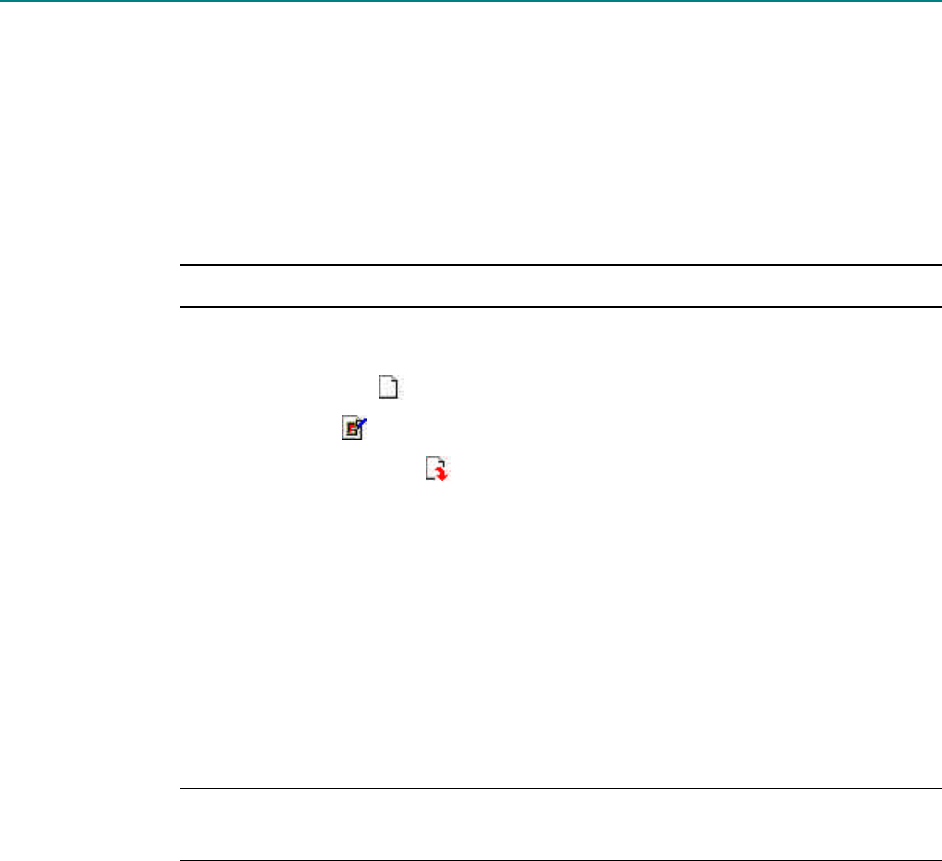
Messaging Features
45
Receiving message attachments
You can download message attachments to your Smartphone. Attachments are
displayed as a list of hyperlinks at the bottom of the e-mail message, and are
preceded by an attachment icon. The text of the hyperlink contains the file
name followed by the size of the attachment, thereby helping you to determine
whether you want to download the attachment.
Note: On POP3 messages, the attachment size is omitted.
The attachment icon has the following three states:
§ Not downloaded
§ Downloaded
§ Marked for download
4 To download an attachment
§ In an open message containing an attachment for download, select the
attachment and press the Action button.
The attachment will be downloaded when you synchronize or request to
send and receive e-mail.
4 To view a downloaded attachment
§ In an open message containing a downloaded attachment, select the
attachment and press the Action button.
Note: You can view attachments only for file types that are supported by
your Smartphone.
Viewing your message folders
Your Smartphone stores messages in the following folders.
§ Deleted Items, where messages that you delete are stored until you empty
this folder.
§ Drafts, where messages that you save before sending are stored.
§ Inbox, where all messages that you receive arrive by default.
§ Outbox, where sent e-mail messages are stored until you synchronize or
connect to your e-mail server. SMS messages are sent immediately over
the network and will appear in your Outbox folder only for a few seconds.
§ Sent Items, where copies of e-mail messages that you send are stored.
4 To view message folders
1. On the Home screen, press the Programs soft key, select Inbox/SMS,
and then press the Action button.
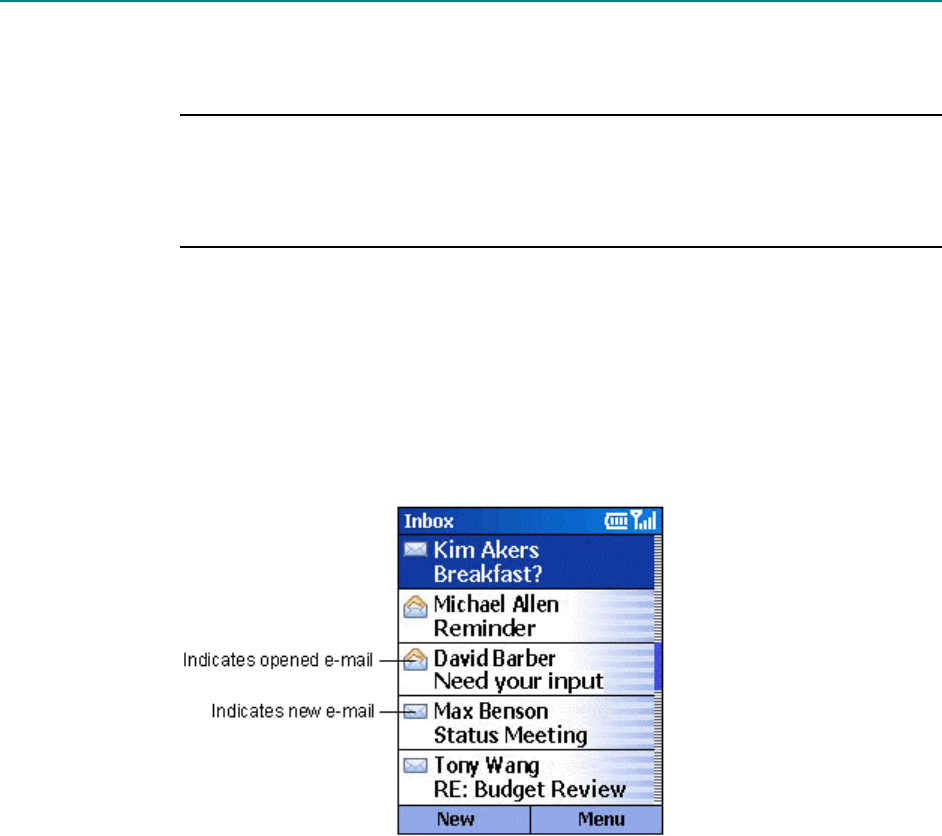
Windows® Powered Smartphone User’s Guide
46
2. Press the Menu soft key, select Show Folders, and then press the Action
button.
Note: If your e-mail account supports folders, you can view multiple folders
to reflect the folder structure that you have created on your e-mail server.
Messages you download from the server will then be placed automatically in
the appropriate folders on your Smartphone.
Managing Inbox
All e-mail and SMS messages are stored in Inbox. By default, the most
recently received messages are displayed at the top of the Inbox list. Using the
menu options, you can quickly compose, delete, forward, and reply to
messages. You can also customize Inbox settings to control the way you send,
receive, and view messages.
Figure 25 Inbox
4 To view Inbox
§ On the Home screen, press the Programs soft key, select Inbox/SMS,
and then press the Action button.
Using Inbox menu options
It is easy to accomplish common messaging tasks from Inbox. Press the New
soft key to compose a new message, or press the Menu soft key to forward,
delete, and reply to messages, access Inbox options you can customize, and
more.
4 To view Inbox menu options
§ On the Home screen, press the Programs soft key, select Inbox/SMS,
press the Action button, and then press the Menu soft key.
The following table lists Inbox menu options and their functions.

Messaging Features
47
Inbox menu option Function
New Message Opens a new message.
Reply Replies to an open or selected message.
Forward Forwards the selected message.
Delete Deletes the selected message.
Mark for Download Retrieves the entire e-mail message from the e-mail
server the next time you connect.
Mark as Read Displays the header text of a message in Inbox in
lightface, indicating that the message has been read.
Mark as Unread Displays the header text of a message in Inbox in
bold, indicating that the message has not been read.
Options Displays a list of Inbox options that you can
customize (see the following table).
Send/Receive E-mail Connects to your e-mail server to send and receive
messages.
Show Folders Displays all message folders.
Customizing Inbox options
You can optimize Inbox for the way you work. For example, you can change
the way your messages are displayed, specify how you want your messages to
be sorted, specify the volume and limit the size of messages you want to
automatically download, change your synchronization schedule, and more.
4 To customize Inbox Options
1. On the Home screen, press the Programs soft key, select Inbox/SMS,
and then press the Action button.
2. Press the Menu soft key, select Options, and then press the Action
button.
3. Select the option to customize, and press the Action button.
4. Modify the settings to change, and press the Done soft key.
The following table lists the Inbox options and their functions.
Inbox option Function
Display Enables you to change the message information
displayed in Inbox.

Windows® Powered Smartphone User’s Guide
48
Inbox option Function
Sending Enables you to specify whether you want to include an
original copy of the message in your reply, save a
copy of your sent messages, or use Unicode for SMS
messages.
Receiving Enables you to specify the volume and limit the size of
new messages that are automatically downloaded.
Predefined Text Enables you to edit the predefined text that you can
insert in messages.
E-mail Setup Enables you to configure your Smartphone to send and
receive e-mail messages. Your service provider or
network administrator will need to provide you with
the necessary information to connect to your e-mail
server.
Automatic
Synchronization
Enables you to set up and change your synchronization
schedule.
Import Messages
from SIM
Enables you to import SMS messages from a SIM card
to Inbox. The messages are not removed from the SIM
card after they are imported.
Transport Options
(IMAP only)
Enables you to select mail transport options. For
example, IMAP4 allows you to download e-mail
messages received during a specified number of days.
Message notifications
Your Smartphone makes a sound to alert you when new messages arrive. The
number of unopened messages is displayed on the Home screen, depending on
your Home screen settings, and an envelope icon is shown on the top of the
display. You are notified in different ways for the types of messages you
receive.
SMS messages: These messages are delivered immediately to your
Smartphone. If your Smartphone is turned off when SMS messages arrive,
you are notified the next time you turn your Smartphone on. A closed
envelope icon , indicating an unopened SMS message, is shown on the top
of the display, accompanied by an SMS sound alert. You can view new SMS
messages in Inbox.
E-mail messages: When you connect to your e-mail server, you are notified
of new e-mail messages by the closed envelope icon shown on the top of
the display, accompanied by an e-mail sound alert. You can view new e-mail
messages in Inbox.

Messaging Features
49
Voice mail messages: You are notified of new voice mail messages available
on the voice mail system by the new voice mail icon shown on the top of
the display. You can then listen to your new voice mail messages by pressing
the Voice Mail soft key, if it is displayed, or by dialing your voice mail
service number.
4 To modify a sound alert for notifications
1. On the Home screen, press the Programs soft key, select Settings, select
Sounds, and then press the Action button.
2. Select the item to modify, press Left or Right to choose a new sound, and
then press the Done soft key.
SMS messages
You can send and receive SMS messages up to 160 characters in size over the
Smartphone network. If an SMS message is longer, it will automatically be
sent in chunks as several small SMS messages, and will then be unified as one
SMS message after all of the small SMS messages have been received.
The advantages of SMS messages include the following:
§ SMS messages are sent instantly.
§ SMS messages can be sent or received during a voice or data call.
§ Most mobile phones support SMS, so most recipients can read SMS
messages you send.
Note: SMS messages are not synchronized, and you cannot use them to send
or receive attachments.
4 To import SMS messages from the SIM card to Inbox
1. On the Home screen, press the Programs soft key, select Inbox/SMS,
and then press the Action button.
2. Press the Menu soft key, select Options, select Import Messages from
SIM, and then press the Action button.
Notes: You cannot export messages from your Smartphone to a SIM card.
SMS messages are not removed from the SIM card after they are imported to
Inbox.
Communicating with MSN Messenger
You can use MSN® Messenger on your Smartphone to send instant messages.
MSN Messenger on your Smartphone provides the same chat environment as

Windows® Powered Smartphone User’s Guide
50
MSN Messenger on your desktop computer. Features of this environment
include:
§ Sending and receiving instant messages.
§ Seeing the status of others in your Messenger contacts list, or changing
your own status (e.g., available, busy, out to lunch).
§ Inviting other people to a chat conversation.
§ Blocking contacts from seeing your status or sending you messages.
Getting started with MSN Messenger
To use MSN Messenger, you need a Microsoft® .NET Passport account unless
you already have a Hotmail account. To set up a Microsoft .NET Passport
account, go to: http://www.passport.com. Once you have this account, you
will need:
§ A connection on your Smartphone, such as a modem or wireless
connection, that enables you to connect to the Internet.
§ To sign in to MSN Messenger using your Microsoft .NET Passport.
4 To sign in and out of MSN Messenger
1. On the Home screen, press the Programs soft key, select MSN
Messenger, press the Action button, and then press the Sign In soft key.
2. Enter your sign-in name (Example: name_123@hotmail.com) and
password, and then press the Sign In soft key.
3. To sign out, press the Menu soft key, select Sign out, and then press the
Action button.
Note: If you do not sign out of MSN Messenger, you will remain on a data
connection. This may result in additional charges from your service provider.
4 To send an instant message
1. Sign in to MSN Messenger.
2. Select the person in MSN Messenger to whom you want to send an instant
message, and press the Send soft key.
3. Enter your message, and press the Send soft key.
Notes: To quickly add common messages, press the Menu soft key, select My
Text, and then select the text you want to use in the message.
For information about text input, see Chapter 2, “The Basics.”

Messaging Features
51
Figure 26 MSN Messenger Options
4 To invite a contact to an ongoing chat
§ Press the Menu soft key, select Invite, and then select a contact.
4 To see who is already chatting, or to change between chats
§ Press the Menu soft key, and select Chats.
4 To accept or change between chats
§ Press the Menu soft key, select Chats, and then select the contact to begin
chatting.
4 To add a contact
§ In the Messenger contacts list, press the Menu soft key, select Add
Contact, and then follow the directions on the screen.
4 To delete a contact
§ In the Messenger contacts list, select the contact's name, press the Menu
soft key, and then select Delete Contact.
4 To block or unblock a contact from seeing your status and
sending you messages
§ In the Messenger contacts list, select the contact's name, press the Menu
soft key, and then select Block or Unblock.
4 To change your status
1. In the Messenger contacts list, select your name, and press the Action
button.
2. Select a status description, such as Away, and press the Action button.
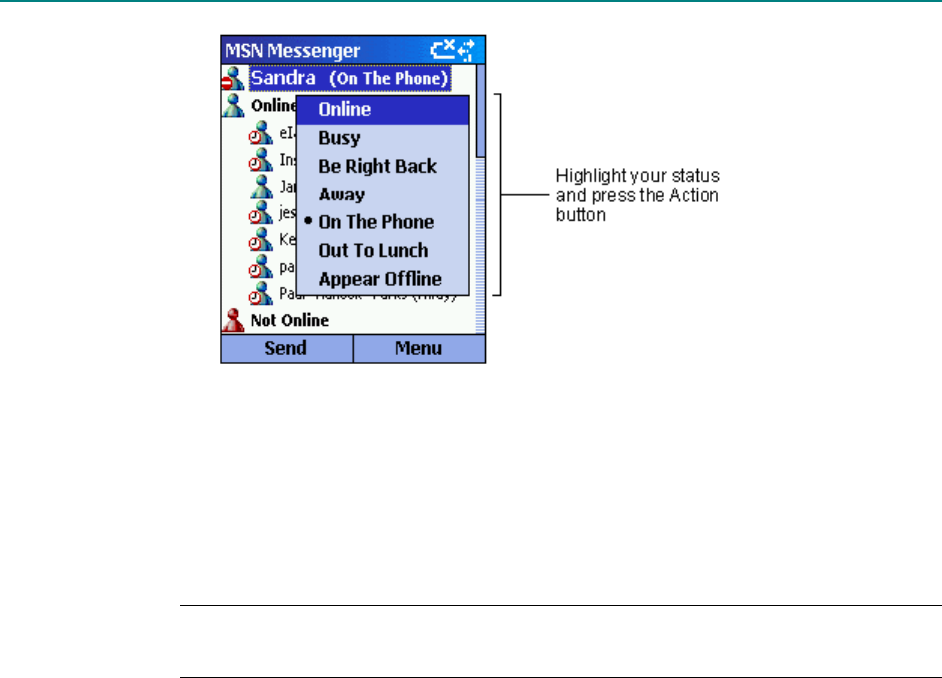
Windows® Powered Smartphone User’s Guide
52
Figure 27 Changing status
4 To change your displayed name
1. In the Messenger contacts list, press the Menu soft key, select Options,
and then select Passport Account.
2. Enter the name that you want others to see when you send instant
messages.
Note: You must be signed in to MSN Messenger to change your displayed
name.

Windows® Powered Smartphone User’s Guide
53
Chapter 6 Contacts, Calendar, and
Tasks
This chapter introduces features on your Smartphone that help you manage
and keep track of contacts, appointments, and schedule, and maintain a
“things to do” list. This chapter also explains how to send and receive contact
and appointment information between your Smartphone and another mobile
device or a desktop computer (beaming data) by using infrared.
For information about synchronizing Contacts, Calendar, and Tasks, see
Chapter 7, “Synchronizing Information.”
Using Contacts
You can think of Contacts as an address book, where you can store
information about people and businesses you communicate with in contact
cards. For example, you can store multiple phone numbers, e-mail and street
addresses, Web pages, and other information that relates to the contact, such
as a birthday or anniversary date. You can use Contacts to dial phone numbers
and compose e-mail and SMS messages directly from a contact card.
The Contacts list
The Contacts list displays the names of your contacts alphabetically, along
with an abbreviation for the default communication method, such as the
person’s work phone number (w) or home phone number (h). This makes it
easy to reach the contact using the method you prefer.
Note: If the contact card includes a work phone number, your Smartphone
will automatically set it as the default number.
4 To access Contacts
§ On the Home screen, press the Programs soft key, select Contacts, and
then press the Action button.
Tip: You can also access Contacts by pressing the Contacts soft key on the
Home screen, if it is displayed.
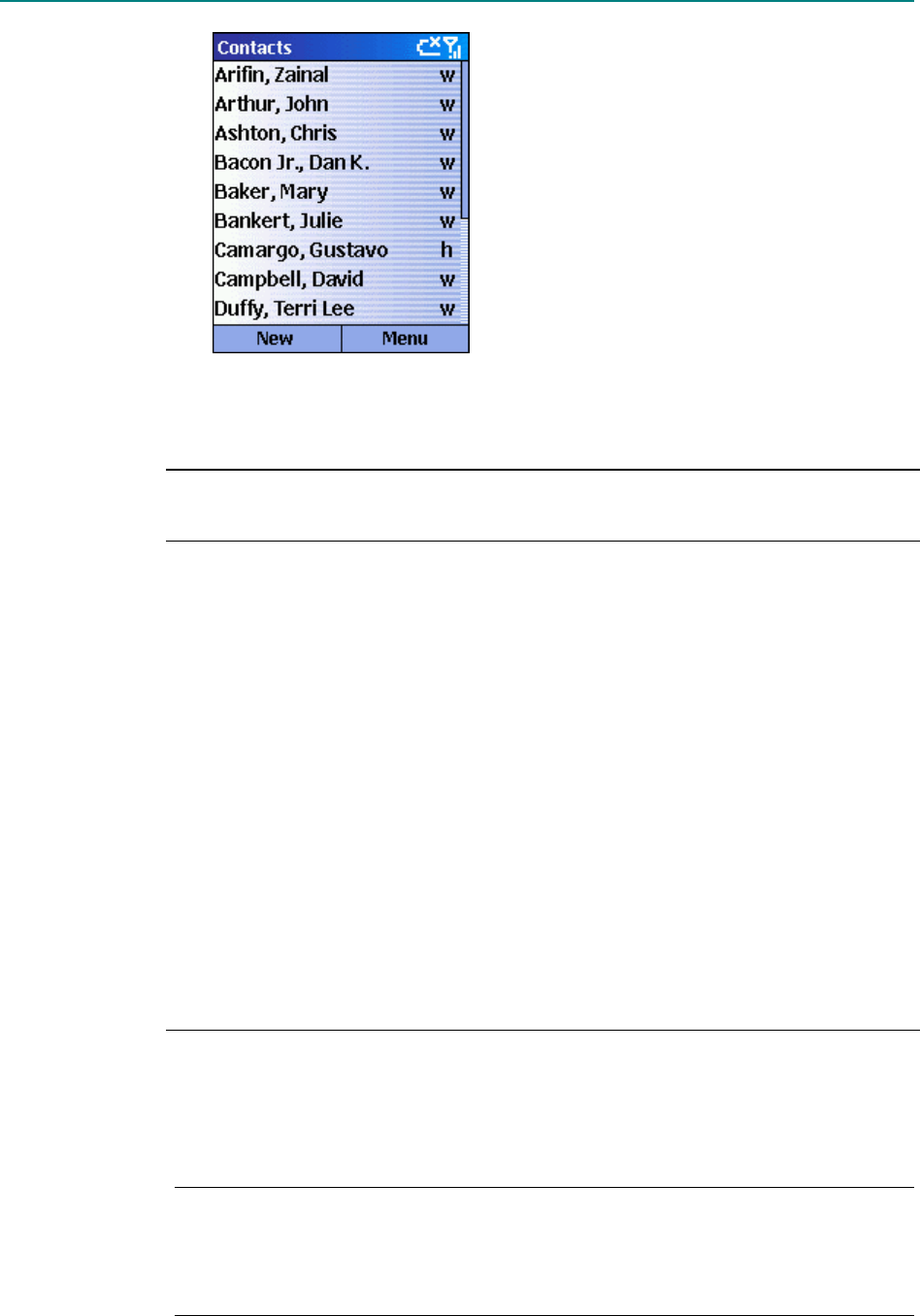
Windows® Powered Smartphone User’s Guide
54
Figure 28 The Contacts list
The following table shows possible abbreviations that might be displayed in
the Contacts list and their meanings.
Contact list
abbreviation Meaning
w Work phone
w2 Second work phone
h Home phone
h2 Second home phone
m Mobile phone
pgr Pager
car Car phone
sms SMS address
e E-mail address
e2 Second e-mail address
e3 Third e-mail address
web Web page
4 To call a contact using the default number
1. On the Home screen, press the Programs soft key, select Contacts, and
then press the Action button.
2. Select the contact to call, and press the Talk button.
Tip: If you have a long list of contacts and you don’t see the contact you
want to call on the first screen, enter the first few letters of the contact’s name.
The Smartphone will search through the entire Contacts list and display the
name.

Contacts, Calendar, and Tasks
55
4 To call a contact using a number other than the default
number
1. On the Home screen, press the Programs soft key, select Contacts, and
then press the Action button.
2. Select the contact, press Left or Right to display the abbreviation for the
number you want to use, and then press the Talk button.
Note: Selecting another abbreviation changes the default number.
4 To find a contact by entering a name
1. On the Home screen, press the Programs soft key, select Contacts, and
then press the Action button.
2. Begin entering the name of the contact you want until the name is
displayed.
For example, to find “Sandra,” enter 7, 2, 6, 3, 7, 2 because these numbers
correspond with the letters for that name on the keypad.
4 To filter contacts
1. On the Home screen, press the Programs soft key, select Contacts, and
then press the Action button.
2. Press the Menu soft key, select Filter, and then press the Action button.
3. Select a filter (Business, Miscellaneous, or Personal), and press the
Action button.
4 To create a new contact
1. On the Home screen, press the Programs soft key, select Contacts, and
then press the Action button.
2. Enter the information for the new contact, and press the Done soft key.
Note: When you create a new contact on your Smartphone, you can
synchronize Contacts with your desktop computer or a server to keep your
contact information up-to-date in all locations.
4 To delete a contact
1. On the Home screen, press the Programs soft key, select Contacts, and
then press the Action button.
2. Select the contact to delete, press the Menu soft key, select Delete, and
then press the Action button.
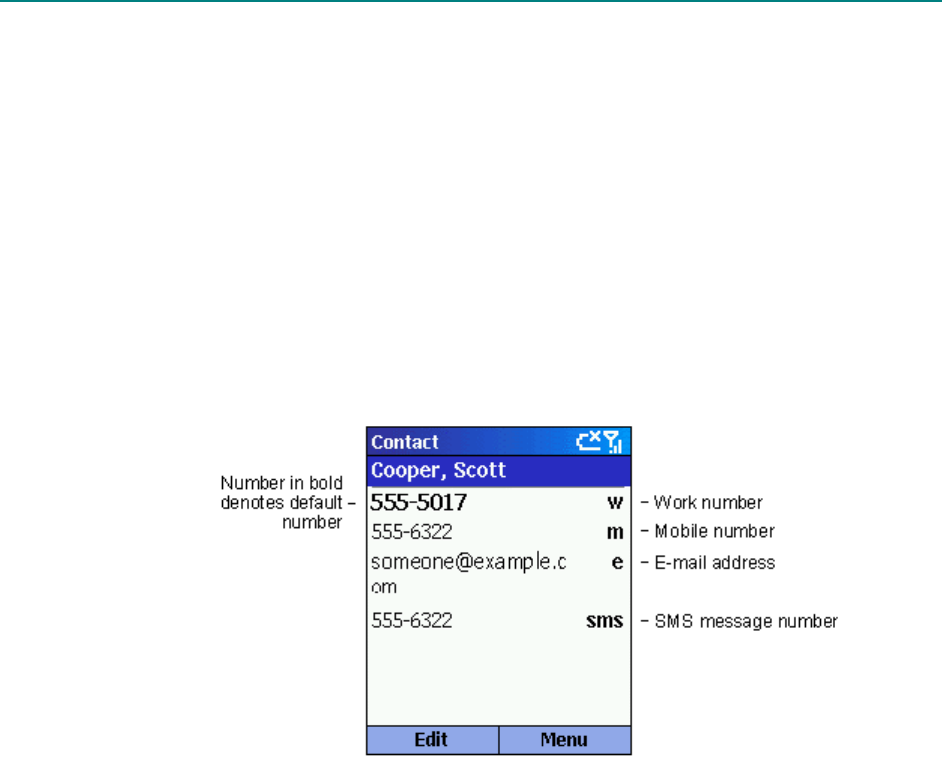
Windows® Powered Smartphone User’s Guide
56
Contact cards
A contact card displays all of the information that you have entered for the
contact, such as the name of the person or business, phone numbers, e-mail
addresses, and more. From a contact card, just select a phone number and
press the Talk button to dial the number. You can also select an e-mail address
and press the Action button to begin composing a message to the contact.
4 To view a contact card
1. On the Home screen, press the Programs soft key, select Contacts, and
then press the Action button.
2. Select the contact to view, and press the Action button.
Figure 29 Contact card
4 To call a contact from a contact card
1. On the Home screen, press the Programs soft key, select Contacts, and
then press the Action button.
2. Select the contact, and press the Action button to open the contact card.
3. Select the number to use, and press the Talk button.
4 To send an e-mail from a contact card
1. On the Home screen, press the Programs soft key, select Contacts, and
then press the Action button.
2. Select the contact to whom you want to send an e-mail message, and press
the Action button to open the contact card.
3. Select the e-mail address, and press the Action button.
4. Enter a subject, press Down, and compose your message in the body text
field, and then press the Send soft key.
4 To edit a contact
1. On the Home screen, press the Programs soft key, select Contacts, and
then press the Action button.

Contacts, Calendar, and Tasks
57
2. Select the contact to edit, and press the Action button to open the contact
card.
3. Press the Menu soft key, select Edit, and then press the Action button.
4. Make the changes, and press the Done soft key.
Using contact card menu options
Using the contact card menu options, you can quickly apply a speed dial or
voice tag to the contact, change the default method for communicating with
the contact, beam the contact card to another mobile device or a desktop
computer using infrared, delete the entire contact card, or edit the contact card
information.
4 To view contact card menu options
1. On the Home screen, press the Programs soft key, select Contacts, and
then press the Action button.
2. Select the contact to open, press the Action button, and then press the
Menu soft key.
The following table lists the contact card menu options and their functions.
Contact card
menu option Function
Add Speed Dial* Enables you to create a shortcut to a phone number, e-
mail address, or Web URL by assigning one or two
numbers as a speed dial.
Add Voice Tag* Enables you to create a shortcut to a phone number, e-
mail address, or Web URL by assigning a recording.
Set As Default Makes the selected phone number or e-mail address the
default communication method for the contact.
Beam Contact Sends the contact card to another mobile device or a
desktop computer using infrared.
Delete Removes the contact card from the Contacts list.
Edit Enables you to modify information in the contact card.
* For information about creating speed dials and voice tags, see Chapter 3,
“Phone Calls.”
Using Calendar
Calendar is the scheduling program on your Smartphone, where you can
create and view appointments, and view your calendar by day, week, or
month.
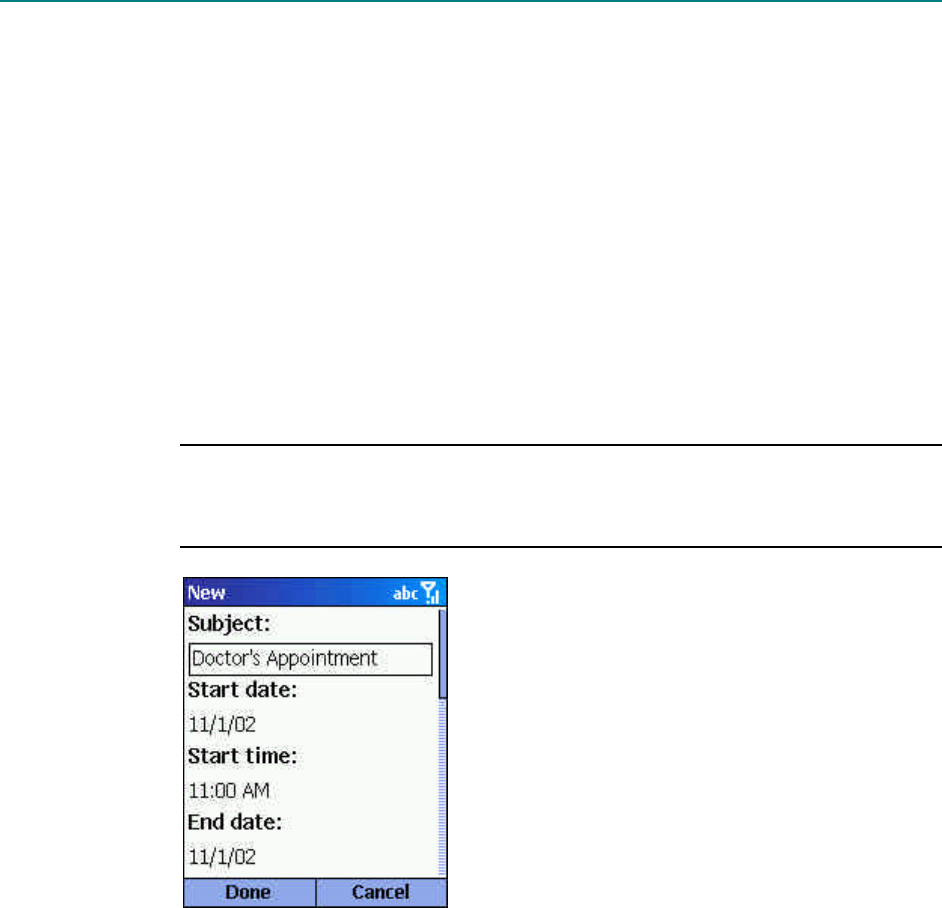
Windows® Powered Smartphone User’s Guide
58
4 To access Calendar
§ On the Home screen, press the Programs soft key, select Calendar, and
then press the Action button.
4 To create a new appointment
1. On the Home screen, press the Programs soft key, select Calendar, and
then press the Action button.
2. Press the Menu soft key, select New, and then press the Action button.
3. Enter information in the fields displayed.
To set a reminder for the appointment, under Reminder, select the amount
of time before the appointment that you want the reminder to appear.
4. Press the Done soft key.
Note: When you create a new appointment on your Smartphone, you can
synchronize Calendar with your desktop computer or a server to keep your
schedule information up-to-date in all locations.
Figure 30 New appointment
4 To view an appointment
1. On the Home screen, press the Programs soft key, select Calendar, and
then press the Action button.
2. Select the appointment to open, and press the Action button.
4 To edit an appointment
1. On the Home screen, press the Programs soft key, select Calendar, and
then press the Action button.
2. Select the appointment to edit, press the Action button, and then press the
Edit soft key.
3. Make the changes, and press the Done soft key.

Contacts, Calendar, and Tasks
59
4 To delete an appointment
1. On the Home screen, press the Programs soft key, select Calendar, and
then press the Action button.
2. Select the appointment to delete, press the Menu soft key, select Delete,
and then press the Action button.
Viewing your schedule
You can view your schedule using three different views: Agenda, Week, and
Month.
Agenda view
The Agenda view in Calendar is the default view for calendar information.
This view displays meetings and appointments scheduled for the current day.
The appointments are shown in chronological order according to start time.
All-day appointments are shown as a single line at the top of the Agenda
view. Up to three all-day events will be displayed.
4 To view your agenda for the current day
§ On the Home screen, press the Programs soft key, select Calendar, and
then press the Action button.
§ If you are in Calendar and you are using the Week or Month view, press
the Menu soft key, select Agenda View, and then press the Action button.
Tip: To look at your agenda for previous or approaching dates, press Left
or Right.
4 To view your agenda for a specific date
1. On the Home screen, press the Programs soft key, select Calendar, and
then press the Action button.
2. Select the Menu soft key, select Go to Date, and then press the Action
button.
3. Enter the date you want to view, and press the Done soft key.
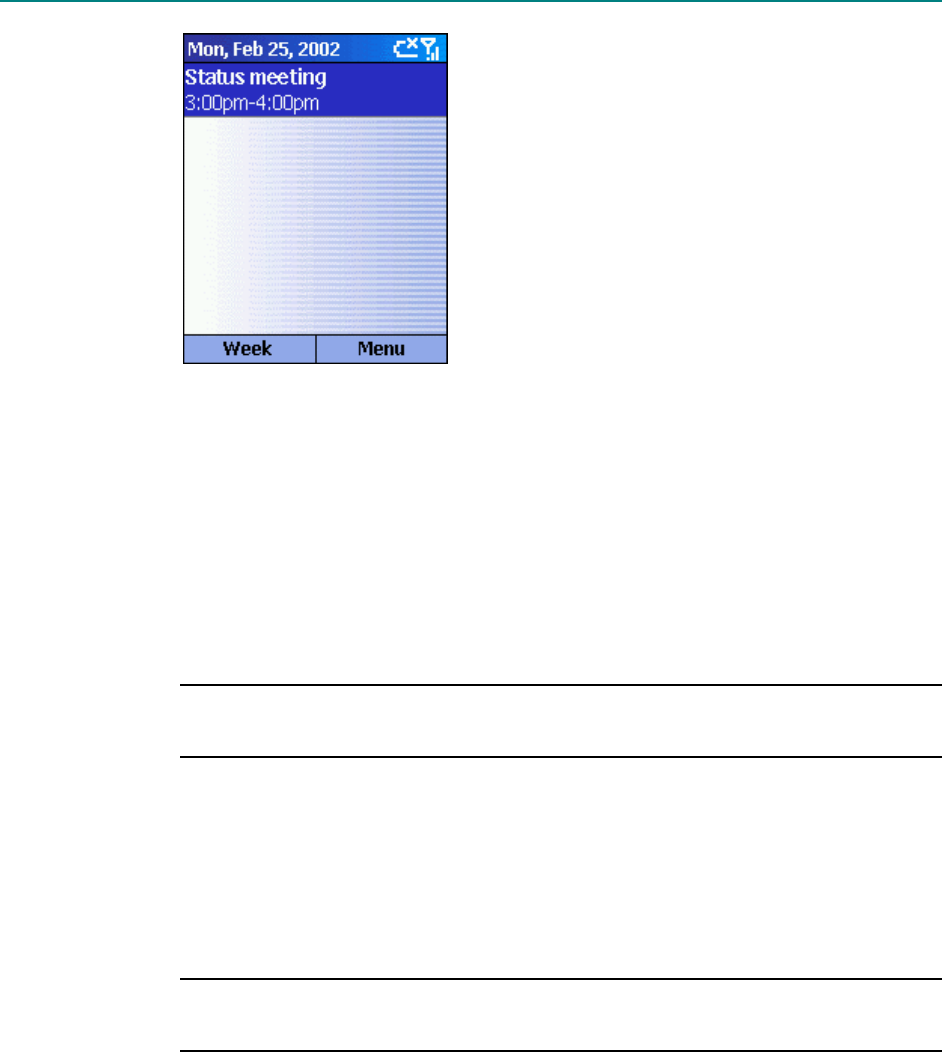
Windows® Powered Smartphone User’s Guide
60
Figure 31 Agenda view
Week view
The Week view shows your schedule for the specified week. This view allows
you to get a quick indication of your free and busy time, and allows you to
create an appointment at a selected time easily.
The Week view displays the hours from 9:00 A.M. to 5:00 P.M. in one-hour
increments by default on the left side of the screen. You can press Up or
Down to show the hours before or after those displayed.
Note: If you press Up or Down and leave Week view, the hours last shown
will be displayed the next time you return to Week view.
4 To view appointments for the week
1. On the Home screen, press the Programs soft key, select Calendar, and
then press the Action button.
2. Press the Menu soft key, select Week View, and then press the Action
button.
Note: To change settings for Week View, press the Menu soft key, select
Options, and then press the Action button.
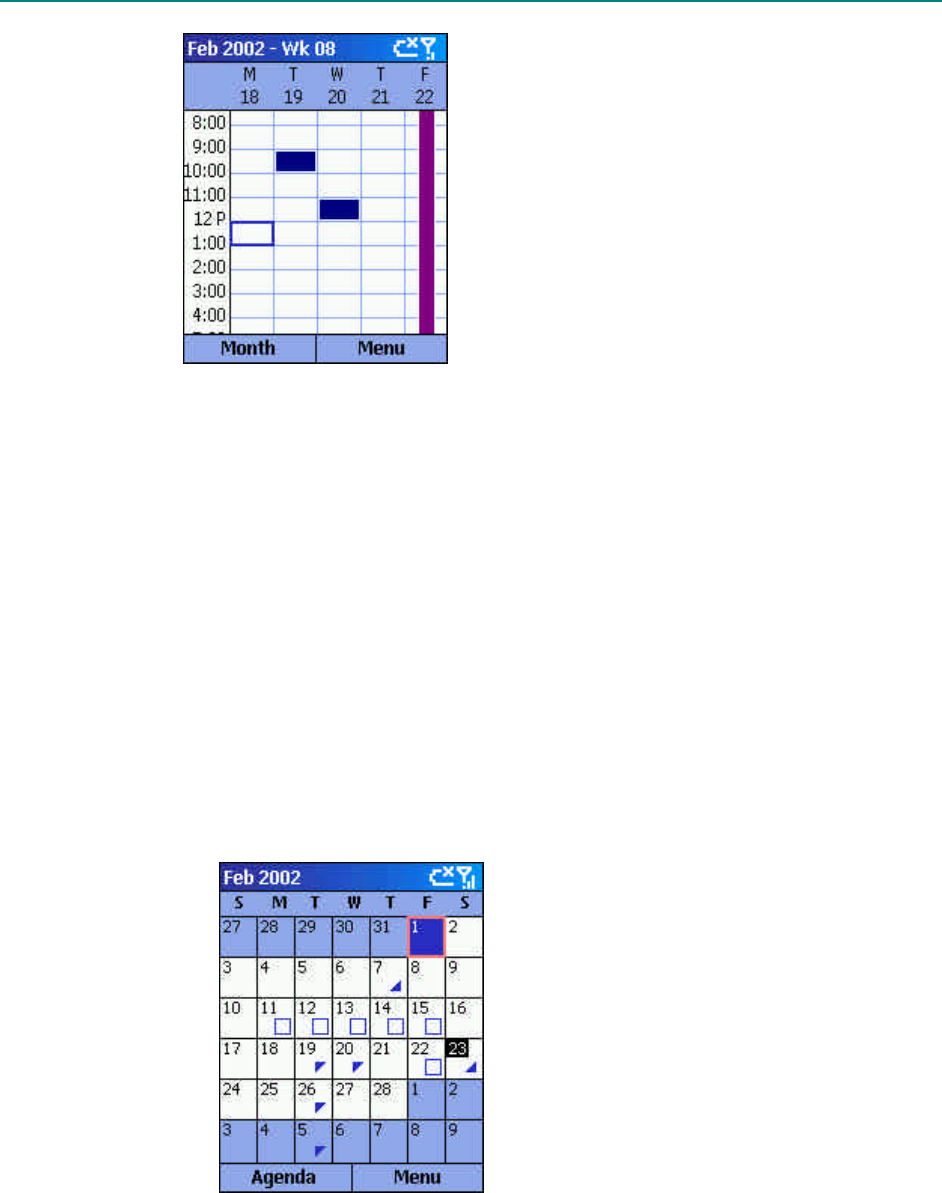
Contacts, Calendar, and Tasks
61
Figure 32 Week view
Month view
The Month view provides an overview of your monthly schedule with arrow
indicators for morning and afternoon appointments. The arrows pointing
upward represent morning appointments, and the arrows pointing downward
represent afternoon appointments. An all-day event is indicated by a box
inside the calendar day. If you have morning and afternoon appointments and
an all day event, a box will surround that calendar day.
4 To view your schedule for the month
1. On the Home screen, press the Programs soft key, select Calendar, and
then press the Action button.
2. Press the Menu soft key, select Month View, and then press the Action
button.
Figure 33 Month view
Importing calendar information
You can import calendar information from another calendar program if it uses
the iCal or vCal format. The calendar information can be imported from
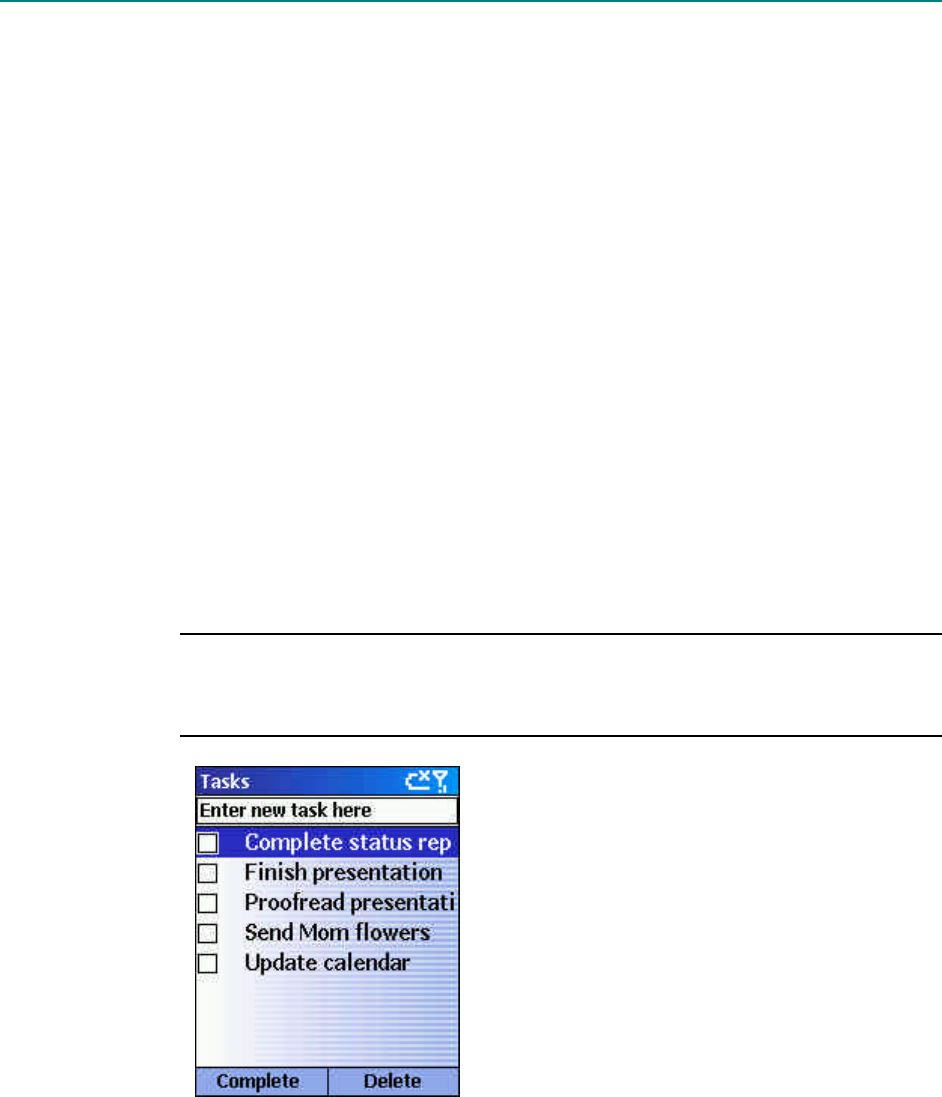
Windows® Powered Smartphone User’s Guide
62
attachments in e-mail messages, SMS messages, links in Microsoft® Pocket
Internet Explorer, or by infrared.
Using Tasks
A task is a personal or work-related project, assignment, or errand to track
through completion. A task can occur once or repeatedly. A recurring task can
repeat at regular intervals or repeat based on the date you mark the task
complete. For example, you might want to pay a bill on the last Friday of
every month, or get a haircut when one month has passed since your last
haircut.
The Tasks list
The Tasks list shows your “things to do” list. An item is followed by an
exclamation mark if it has been marked as high priority and a down arrow if it
has been marked as low priority. Overdue tasks are displayed bold and red on
color phones. Completed tasks are displayed with the corresponding check
box selected.
Note: If you synchronize tasks with your desktop computer, completed tasks
are removed from your Smartphone after synchronization. They are then
displayed in gray with a strikethrough on your desktop computer.
Figure 34 Tasks list
Using the Tasks list
4 To create a new task
1. On the Home screen, press the Programs soft key, select More, select
Tasks, and then press the Action button.
2. Select the Enter new task here field, enter the task, and then press the
Action button.

Contacts, Calendar, and Tasks
63
Notes: When you create a new task on your Smartphone, you can synchronize
tasks with your desktop computer to keep your Tasks list up-to-date in both
locations.
If you create a new task with a reminder on your desktop computer, you can
synchronize tasks with your Smartphone to hear the reminder on your
Smartphone.
4 To mark a task as complete
1. On the Home screen, press the Programs soft key, select More, select
Tasks, and then press the Action button.
2. Select the task, and press the Complete soft key.
4 To mark a completed task as incomplete
1. On the Home screen, press the Programs soft key, select More, select
Tasks, and then press the Action button.
2. Select the task, and press the Activate soft key.
4 To delete a task from the Tasks list
1. On the Home screen, press the Programs soft key, select More, select
Tasks, and then press the Action button.
2. Select the task, and press the Delete soft key.
Creating Voice Notes
Voice Notes are used to create short voice recordings. Recordings are
included in the All Notes list and are named consecutively (Recording 1,
Recording 2, and so on).
4 To create a Voice Note
1. Hold the Smartphone’s microphone near your mouth.
2. Press the Record button, and press the Record soft key to begin recording
your voice note.
3. Press the Stop soft key to stop recording your voice note.
Note: To listen to a recording, select it from the All Notes list, press the
Menu soft key, select Play, and then press the Action button.
4 To rename a recording
1. Press the Record button, and select the recording to rename.
2. Press the Menu soft key, select Rename, and then press the Action
button.

Windows® Powered Smartphone User’s Guide
64
3. Under Name, enter a new name for the recording, and press the Done soft
key.
Beaming information
You can use the infrared port on your Smartphone to send and receive (beam)
calendar appointments and contact cards between your Smartphone and
another mobile device or a desktop computer that has an infrared port and
supports VCards and VCal.
4 To beam a contact
1. On the Home screen, press the Programs soft key, select Contacts, and
then press the Action button.
2. Select the contact to beam, press the Menu soft key, select Beam
Contact, and then press the Action button. Align the infrared ports so that
they are unobstructed and within close range of each other, and press the
Beam soft key.
Status information will then be displayed, indicating the name of the
device your Smartphone is beaming to, and whether the beaming process
is pending, done, or has failed.
4 To beam an appointment
1. On the Home screen, press the Programs soft key, select Calendar, and
then press the Action button.
2. Select the appointment to beam, and press the Action button to open the
appointment.
3. Press the Menu soft key, select Beam Appointment, and then press the
Action button.
4. Align the infrared ports so that they are unobstructed and within close
range of each other, and press the Beam soft key.
Status information will then be displayed, indicating the name of the
device your Smartphone is beaming to, and whether the beaming process
is pending, done, or has failed.
4 To receive beamed information
1. On the Home screen, press the Programs soft key, select More, select
Accessories, and then press the Action button.
2. Select Infrared Receive, and press the Action button.
3. Align the infrared ports so that they are unobstructed and within close
range of each other, and press the Yes soft key to receive the information.

Contacts, Calendar, and Tasks
65
Note: Your Smartphone can receive beamed files of any type, but some files
may need to be copied to your desktop computer for viewing.

Windows® Powered Smartphone User’s Guide
66

Windows® Powered Smartphone User’s Guide
67
Chapter 7 Synchronizing Information
This chapter introduces basic concepts and features of Microsoft®
ActiveSync®, and explains how to set up Server ActiveSync®, synchronize
remotely, and create a synchronization schedule. This chapter also gives an
overview of the different types of Microsoft® Outlook® information you can
synchronize.
For more information about ActiveSync, see ActiveSync Help on your
desktop computer.
Using ActiveSync
You can synchronize information on your desktop computer and/or a
Microsoft® Exchange Server with the information on your Smartphone.
ActiveSync compares the information on your Smartphone with the
information on your desktop computer and/or the server and updates all
locations with the most recent information. With ActiveSync, you can:
§ Keep your Outlook information up-to-date by synchronizing your
Smartphone with your desktop computer.
§ Choose to synchronize Inbox, Calendar, and Contacts with a server so that
you have the latest information, even when your desktop computer is
turned off.
§ Copy (rather than synchronize) files between your Smartphone and your
desktop computer.
§ Control when synchronization occurs by selecting a synchronization
schedule.
§ Select which information types are synchronized and control how much
information is synchronized. For example, you can choose how many
weeks of past appointments to synchronize.
Note: Using Server ActiveSync, you can synchronize information directly
with a Microsoft Exchange Server if your company is running Microsoft®
Mobile Information Server 2002 or later.
Installing ActiveSync
Before you begin synchronization, install ActiveSync on your desktop
computer from the Smartphone Companion CD. For more information about
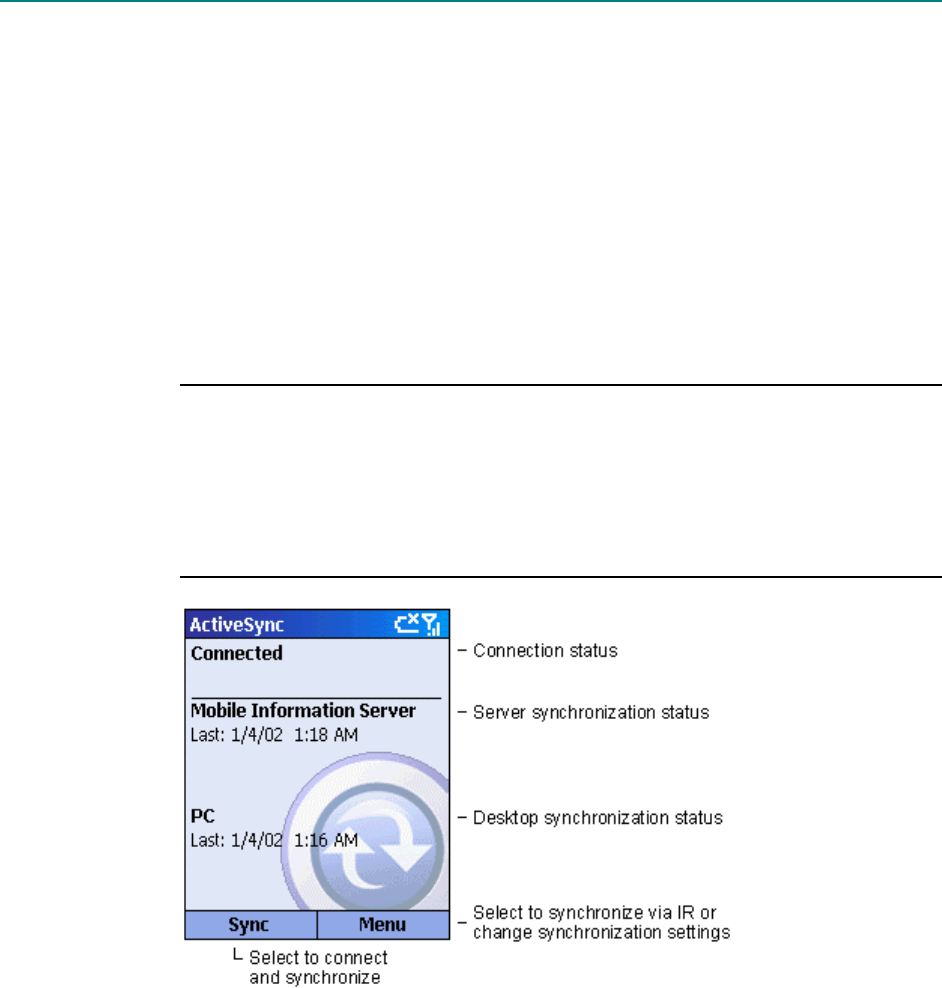
Windows® Powered Smartphone User’s Guide
68
installing ActiveSync, see the Quick Start Card. ActiveSync is already installed
on your Smartphone.
Creating a Partnership
After the installation is complete, the New Partnership Wizard helps you set
up a partnership between your Smartphone and your desktop computer and/or
a server so that you can start synchronizing information and customizing your
synchronization settings. Your first synchronization process will automatically
begin when you finish using the wizard. After the first synchronization, you
will notice that your Outlook information now appears on your Smartphone.
Warning: To prevent synchronization problems, select Synchronize with
Microsoft Mobile Information Server and/or this desktop computer in the
New Partnership Wizard only if you are certain that your company is running
Microsoft Mobile Information Server 2002 or later and you know the server
name. Otherwise, select Synchronize with this desktop computer. For more
information, contact your network administrator or service provider.
Figure 35 Synchronization in progress
4 To start and stop synchronization
1. On the Home screen, press the Programs soft key, select ActiveSync, and
then press the Action button.
2. To start synchronization, press the Sync soft key; to stop synchronization,
press the Stop soft key.
Setting up Server ActiveSync
Before you can begin to synchronize information with a server, you may need
to request server configuration information, such as your user name,
password, and the name of the Microsoft Mobile Information Server, either
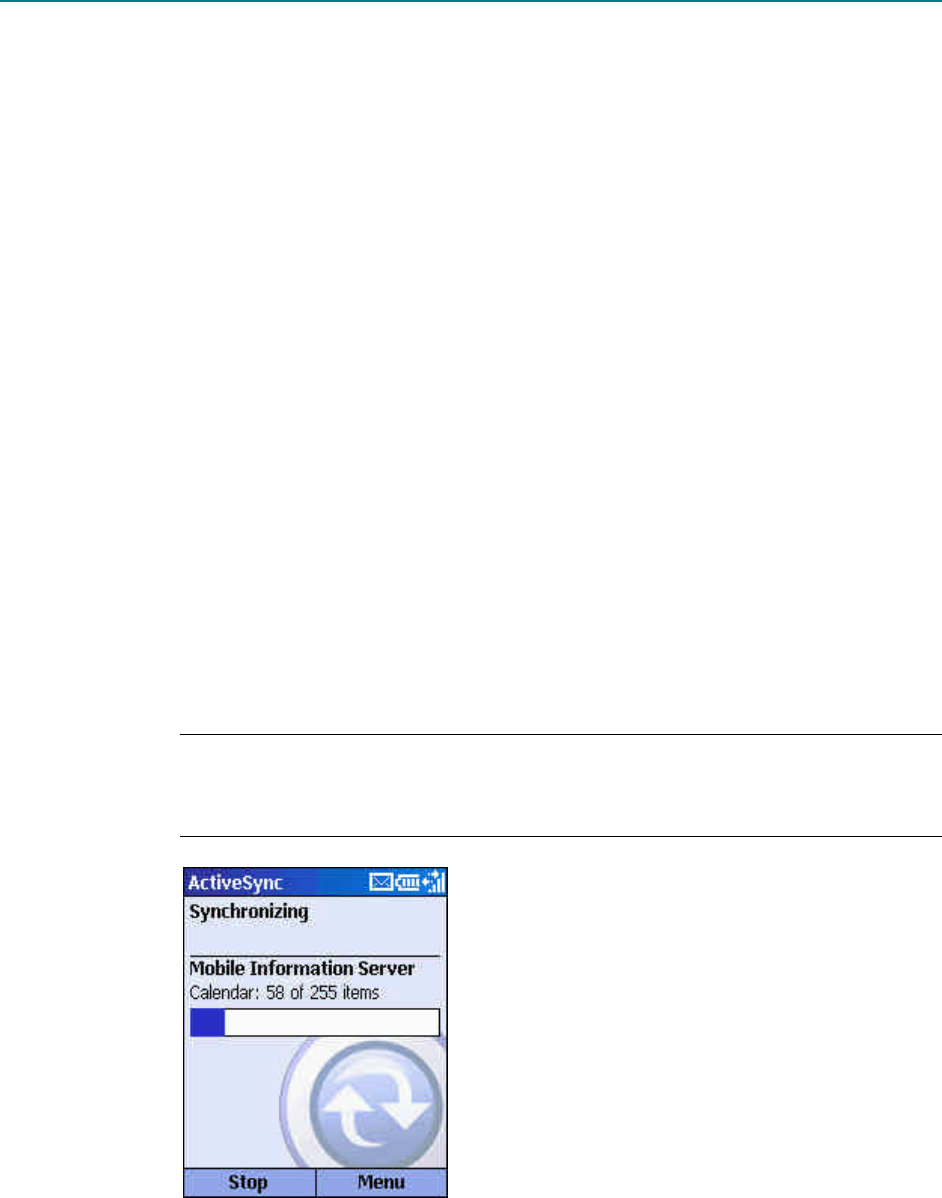
Synchronizing Information
69
from your service provider or from your corporate network administrator.
This configuration information may have already been set up on your
Smartphone, or you may have already been given this information.
4 To set up Server ActiveSync
1. On the Home screen, press the Programs soft key, select ActiveSync, and
then press the Action button.
2. Press the Menu soft key, select Options, and then press the Action
button.
3. Select Connection, and press the Action button.
4. Under Username, enter your Microsoft Exchange user name.
5. Under Password, enter your Microsoft Exchange password.
6. Under Domain, enter the name of the domain for your Microsoft
Exchange Server (if required).
7. Select Save password if you want your Smartphone to save your
password so that you need not enter it repeatedly.
8. In Server name, enter the name of the Microsoft Mobile Information
Server to which you want to connect.
9. Press the Done soft key twice.
10. To begin synchronizing with the server, press the Sync soft key.
Note: You can also set up a connection to synchronize remotely with a server
when you first create a partnership between your Smartphone and desktop
computer.
Figure 36 Active Sync status screen
4 To stop synchronizing with a server
You can stop synchronizing an information type with a server on your
Smartphone. However, to change to synchronizing that information type with
your desktop computer instead, you will need to change the synchronization

Windows® Powered Smartphone User’s Guide
70
settings on the desktop computer. For more information about
synchronization, see ActiveSync Help on the desktop computer.
1. On the Home screen, press the Programs soft key, select ActiveSync, and
then press the Action button.
2. Press the Menu soft key, select Options, and then select the information
type that you no longer want to synchronize with a server, such as
Calendar, Contacts, or Inbox.
3. Clear the check box next to the information type that you no longer want
to synchronize with a server, and press the Done soft key.
Synchronizing Remotely
You can synchronize remotely with your desktop computer, or with a server,
if you have set up Server ActiveSync.
4 To synchronize remotely with a desktop computer
1. On the Home screen, press the Programs soft key, select ActiveSync, and
then press the Action button.
2. Press the Menu soft key, select Options , and then press the Action
button.
3. Select PC Settings, and then press the Action button.
4. Select Include PC sync remotely when synchronizing, and then press
the Action button.
5. Under Connect To, select the appropriate computer name, and press the
Done soft key.
6. To start synchronization, press the Sync soft key.
Note: To synchronize remotely with a desktop computer, it must be turned
on.
4 To synchronize remotely with a server
1. On the Home screen, press the Programs soft key, select ActiveSync, and
then press the Action button.
2. Press the Menu soft key, select Options, and then press the Action
button.
3. Select the information type to synchronize with the server, press the
Action button, select the Synchronize [Information type] check box, and
then press the Done key.

Synchronizing Information
71
Creating a server synchronization schedule
You can create a server synchronization schedule so that your information is
automatically synchronized with the server at time intervals that you specify.
4 To create a schedule to synchronize with a server when your
Smartphone is connected to a desktop computer
1. On the Home screen, press the Programs soft key, select ActiveSync, and
then press the Action button.
2. Press the Menu soft key, select Options, select Schedule, and then press
the Action button.
3. Select the When connected to my PC, synchronize with the server
every check box, and select a length of time.
4. Press the Done soft key.
4 To create a schedule to synchronize with a server when your
Smartphone is not connected to a desktop computer
(synchronize wirelessly)
1. On the Home screen, press the Programs soft key, select ActiveSync, and
then press the Action button.
2. Press the Menu soft key, select Options, select Schedule, and then press
the Action button.
3. Select the When not connected to my PC, synchronize with the server
every check box and select a length of time.
4. Press the Done soft key.
Synchronizing information
This section provides an overview of the types of Outlook information you
can synchronize. By default, ActiveSync does not automatically synchronize
all types of Outlook information. Use ActiveSync options to turn
synchronization on and off for specific information types.
Synchronizing Inbox
When you select Inbox for synchronization in ActiveSync, e-mail messages
are synchronized as part of the general synchronization process. During
synchronization, the following events occur:
§ Messages are copied from the Outlook Inbox folder on your desktop
computer, or from a Microsoft Exchange Server, to the Inbox folder on
your Smartphone.
§ By default, when synchronizing Inbox information with your desktop
computer, you will receive only messages from the last three days and the

Windows® Powered Smartphone User’s Guide
72
first .5 KB of each new message. You can also choose to download file
attachments.
§ By default, when synchronizing Inbox information with a server, you will
receive only messages from the last three days and the first 500 bytes of
each new message.
§ The messages on your Smartphone and on your desktop computer are
linked. When you delete a message on your Smartphone, it is deleted from
your desktop computer the next time you synchronize, and vice versa.
§ Messages in subfolders in other e-mail folders in Outlook are
synchronized only if the folders have been selected for synchronization in
Inbox on your Smartphone.
Note: SMS messages are not received in Inbox through synchronization.
Instead, they are sent to your Smartphone by way of your service provider.
Synchronizing Calendar
Calendar items stored on your Smartphone can be synchronized with calendar
items stored on your desktop computer or on a Microsoft Exchange Server.
By default, calendar items from the last two weeks will be synchronized.
Calendar items created on your Smartphone are copied to your desktop
computer and/or server during synchronization, and vice versa. Similarly,
Calendar items that are deleted from your Smartphone are deleted from your
desktop computer and/or server during synchronization, and vice versa. This
keeps your information up-to-date in all locations.
Synchronizing Contacts
Contacts stored on your Smartphone can be synchronized with contacts stored
on your desktop computer or on a Microsoft Exchange Server. By default, all
of your contacts will be synchronized.
Contacts created on your Smartphone are copied to your desktop computer
and/or server during synchronization, and vice versa. Similarly, contacts that
are deleted from your Smartphone are deleted from your desktop computer
and/or server during synchronization, and vice versa. This keeps your
information up-to-date in all locations.
Synchronizing Tasks
Tasks stored on your Smartphone can be synchronized with tasks stored on
your desktop computer. Task synchronization is automatically selected in
ActiveSync. By default, all of your incomplete tasks will be synchronized.

Synchronizing Information
73
Tasks created on your Smartphone are copied to your desktop computer
during synchronization, and vice versa. Similarly, tasks that are deleted from
your Smartphone are deleted from your desktop computer during
synchronization, and vice versa. This keeps your information up-to-date in all
locations.
Note: Tasks can be synchronized only with your desktop computer; they
cannot be synchronized with a server.
Synchronizing using an infrared connection
You can use an infrared connection to create a direct connection between your
Smartphone and another mobile device or desktop computer quickly. This
method is ideal for quickly changing between multiple devices because there
are no cables or adapters to change. When creating a partnership, you must
connect using infrared, a cable, or a cradle connection.
For more information about synchronizing using an infrared connection or
other connection types, see ActiveSync Help on your desktop computer.
ActiveSync errors
Whenever ActiveSync cannot successfully synchronize your information, it
displays an error on your Smartphone.
4 To view more information about an ActiveSync error
§ Press the Action button when the error text is displayed. ActiveSync will
then display more information about the error that occurred.
Note: Some types of errors can interfere with automatic synchronization. If
you suspect that a scheduled automatic synchronization has not occurred, you
should attempt to manually synchronize your information. Successfully
completing manual synchronization will reset automatic synchronization. For
more information, see the “Synchronizing Information” section of ActiveSync
Help on your desktop computer.

Windows® Powered Smartphone User’s Guide
74

Windows® Powered Smartphone User’s Guide
75
Chapter 8 Internet, Entertainment,
and More
This chapter explains how to browse the Web using Microsoft® Pocket
Internet Explorer, play audio and video files using Microsoft® Windows
Media™ Player, set up a modem link, play Solitaire, and use Calculator.
Using Internet Explorer
Using Pocket Internet Explorer, you can browse the Web on your
Smartphone. Pocket Internet Explorer on your Smartphone supports WAP
(Wireless Application Protocol), HTML (Hypertext Markup Language), and
cHTML (compact Hypertext Markup Language). The browser supports
images and sounds, but it does not support frames on a Web page.
4 To access Pocket Internet Explorer
§ On the Home screen, press the Programs soft key, select Internet
Explorer, and then press the Action button.
4 To disconnect from the Internet
§ Press the End button.
Navigating in Pocket Internet Explorer
With Pocket Internet Explorer, the Favorites list is displayed as the main
screen instead of a home page. You can add your own favorites to this list for
quick access to Web sites you frequently visit. You can also access
Smartphone How-To information any time on the Web from the Favorites list.
Access your Favorites list from any Web page by simply pressing the
Favorites soft key.
4 To view a favorite
1. On the Home screen, press the Programs soft key, select Internet
Explorer, and then press the Action button.
2. Select a favorite to view, and press the Go soft key.
4 To activate a link
§ Select a link, and press the Action button.
Note: Scroll vertically or horizontally to see all available links.

Windows® Powered Smartphone User’s Guide
76
4 To access Smartphone How-To information in Favorites
1. On the Home screen, press the Programs soft key, select Internet
Explorer, and then press the Action button.
2. Select Smartphone How To, and press the Action button.
4 To enter the address of a Web site
1. On the Home screen, press the Programs soft key, select Internet
Explorer, and then press the Action button.
2. Press the Menu soft key, select Go To, and then press the Action button.
3. Enter the Web address, and press the Go soft key.
4 To return to a Web page you previously visited in the same
session
§ From a Web page, press the Back button.
4 To view a list of the most recently-visited Web pages
1. On the Home screen, press the Programs soft key, select Internet
Explorer, and then press the Action button.
2. Press the Menu soft key, select Go To, and then press the Action button.
3. Select View History, and press the Go soft key.
4 To visit a Web page on the History list
1. On the Home screen, press the Programs soft key, select Internet
Explorer, and then press the Action button.
2. Press the Menu soft key, select Go To, and then press the Action button.
3. Select View History, and press the Go soft key.
4. Select the URL for a Web page, and press the Go soft key.
Tip: While you are connected to the Internet, you can change between
Pocket Internet Explorer and other programs on your Smartphone by pressing
the Home button. This will not close your Internet connection. To return to the
page you were viewing, press the Back button.
Using the Favorites list
If you see a Web page you want to visit another time, mark it as a favorite.
The next time you want to visit that Web page, just select it from your
Favorites list.
4 To add a Web page to your Favorites list
1. On the Home screen, press the Programs soft key, select Internet
Explorer, and then press the Action button.
2. Press the Menu soft key, select Go To, and then press the Action button.
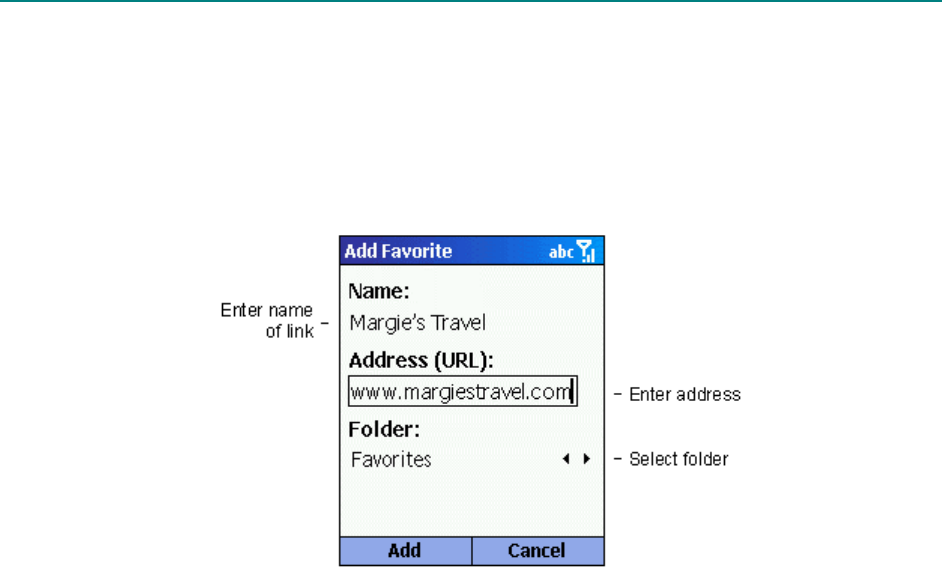
Internet, Entertainment, and More
77
3. Enter the Web URL, and press the Go soft key.
4. Press the Menu soft key, select Add Favorite, and then press the Action
button.
5. Enter a name for the Web site as you want it to appear on your Favorites
list, and press the Add soft key.
Figure 37 Adding a favorite
4 To create a new folder in Favorites
1. On the Home screen, press the Programs soft key, select Internet
Explorer, and then press the Action button.
2. Press the Menu soft key, select Add Folder, and then press the Action
button.
3. Under Name, enter a name for the folder, and press the Add soft key.
4 To delete a favorite
3. On the Home screen, press the Programs soft key, select Internet
Explorer, and then press the Action button.
4. Select the favorite to delete, press the Menu soft key, select Delete, and
then press the Action button.
Cached Web pages
The Smartphone caches Web pages as they are downloaded to your
Smartphone and stores them on your Smartphone until the cache is full. If you
go to a page that is already stored on your Smartphone, you will see the stored
version when you select the page. Choose Refresh from the menu to see the
latest Web content for that page.
4 To refresh a Web page you have recently visited
1. On the Home screen, press the Programs soft key, select Internet
Explorer, and then press the Action button.

Windows® Powered Smartphone User’s Guide
78
2. Select the Web page to revisit from your Favorites list or History list, and
press the Go soft key.
3. Press the Menu soft key, select Refresh, and then press the Action button.
Pocket Internet Explorer options
Use Pocket Internet Explorer options to change the way Web pages are
displayed, change the network you want to connect to, and free space on your
Smartphone.
4 To view Pocket Internet Explorer options
1. On the Home screen, press the Programs soft key, select Internet
Explorer, and then press the Action button.
2. Press the Menu soft key, select Options, and then press the Action
button.
Pocket Internet
Explorer Options Function
General Enables you to change the way Web pages are
downloaded and displayed. For example, you can
choose to omit displaying images, turn off sound, fit the
Web page to the screen, request a warning before
moving from secure Web pages to nonsecure Web
pages, allow cookies, or change the language.
Connections Enables you to change the network to connect to. For
example, change from “The Internet” to “My Corporate
Network.”
Memory Enables you to clear temporary Internet files, cookies,
and your Web history.
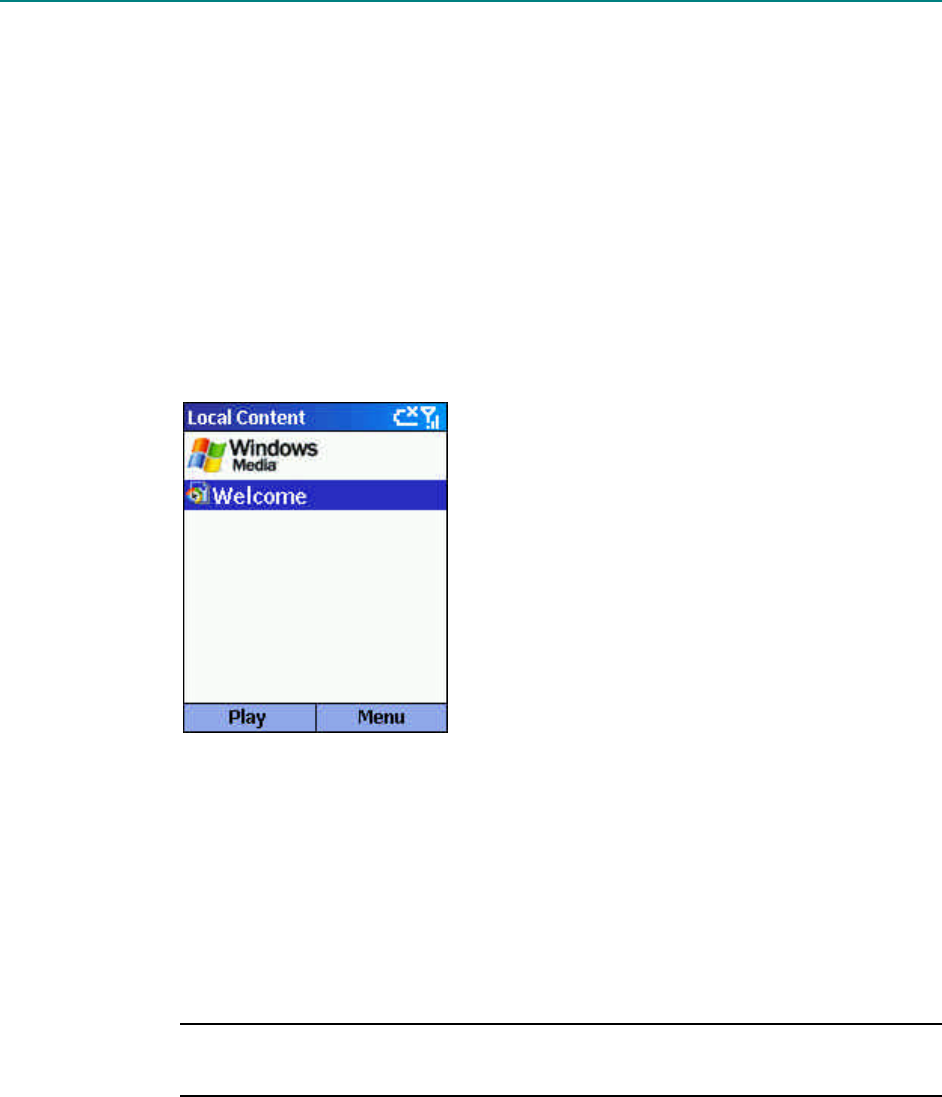
Internet, Entertainment, and More
79
Using Media Player
Using Windows Media™ Player 7.0 or later, you can play Windows Media
audio and video files and MP3 audio files on your Smartphone. You can also
copy digital music and video directly from your desktop computer to your
Smartphone by using Media Player or ActiveSync. For more information
about copying files to your Smartphone, see the Media Player Help on your
desktop computer.
Media Player is easy to use; the controls are similar to the buttons on a
compact disc player.
Figure 38 Local Content screen
Playing files
You can play audio or video files, skip to another song or video, and increase
or decrease the volume.
4 To play or stop a file
§ On the Local Content screen, press the Play soft key.
Note: To access the Local Content screen, press the Select soft key.
4 To skip to the beginning of the current file
§ Press Left.
4 To skip to the beginning of the previous file
§ Press Left twice quickly.
4 To skip to the next file
§ Press Right.
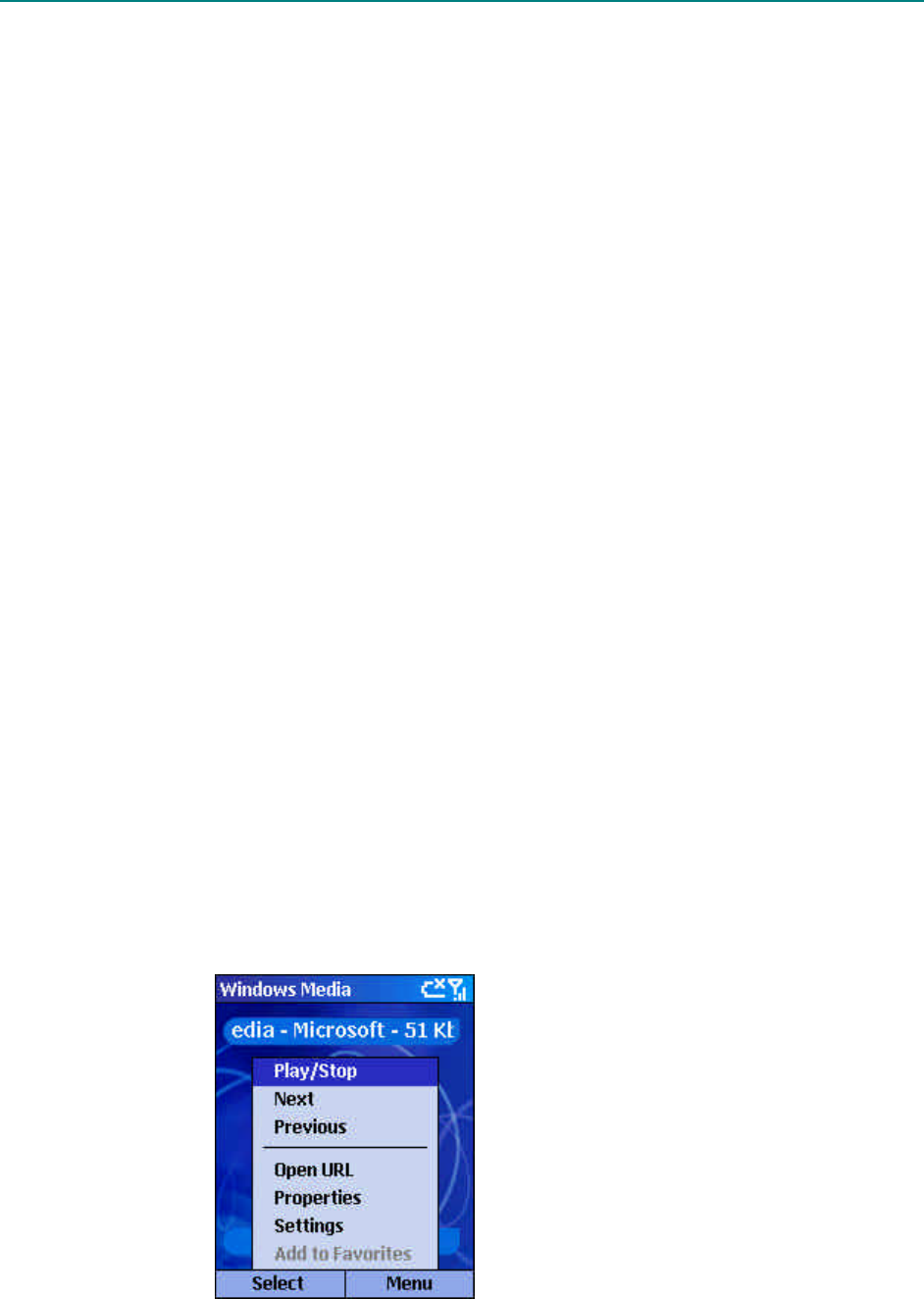
Windows® Powered Smartphone User’s Guide
80
4 To adjust the volume
§ Use the Volume control to increase or decrease the volume.
4 To play a streaming media file on a network
1. On the Local Content screen, press the Menu soft key, select Open
URL, and then press the Action button.
2. Enter the Web URL, and press the Play soft key.
4 To play files randomly
1. On the Local Content screen, press the Menu soft key, select Settings,
and then press the Action button.
2. Select the Shuffle check box, and press the Done soft key.
4 To play files repeatedly
1. On the Local Content screen, press the Menu soft key, select Settings,
and then press the Action button.
2. Select the Repeat check box, and press the Done soft key.
4 To stop playback while using another program
1. On the Local Content screen, press the Menu soft key, select Settings,
and then press the Action button.
2. Select the Background play check box, and press the Done soft key.
Menu options when playing a file
When you are playing a file, you can use the menu options to start and stop
playback, skip to the next or previous file, display information about a file,
configure volume and playback settings, or add files to your Favorites playlist.
4 To access menu options when playing a file
§ Press the Menu soft key.
Figure 39 Playback controls

Internet, Entertainment, and More
81
The following table lists the menu options and their functions that are
available when you play a file.
Menu options when
playing a file
Function
Play/Stop Plays or stops playback of the current file.
Next Skips to the next file on the current playlist. This
command is not available if the last file is the current
selection.
Previous Skips to the beginning of the current file on the current
playlist. If no file is playing, this command skips to the
previous file on the current playlist.
Open URL Plays a streaming media file on a network (for
example, content streamed from an Internet radio
station).
Properties Displays information about the file that is playing.
Settings Displays the Settings options, which enable you to
adjust the volume and various playback options.
Add to Favorites Adds the streaming media file that is playing to the
Favorites playlist.
Local Content screen menu options
By using the menu options from the Local Content screen, you can start and
stop playback, add files to your Favorites playlist, display information about a
file, configure volume and playback settings, or delete a file.
4 To access Local Content screen menu options
§ Press the Menu soft key.
The following table lists the Local Content screen menu options and their
functions.
Local Content
menu option Function
Play/Stop Plays or stops playback of the current file.
Local Content Displays the Local Content view playlist.
Favorites Displays the Favorites view playlist.
Open URL Plays a streaming media file on a network (for example,
content streamed from an Internet radio station).
Properties Displays information about the selected file.

Windows® Powered Smartphone User’s Guide
82
Local Content
menu option Function
Settings Displays the Settings screen, which enables you to
adjust the volume and specify various playback options.
Delete Permanently deletes the selected file from the
Smartphone.
Using Media Player Favorites
You can connect to your favorite streaming media file and add it to Favorites.
The next time you want to listen to the streaming media file, just select it from
Favorites.
4 To connect to a streaming media file
1. On the Local Content screen, press the Menu soft key, select Open
URL, and then press the Action button.
2. Enter the URL, and press the Play soft key.
4 To add a streaming media file to Favorites
1. Connect to a streaming media file on the Internet or other network.
2. Press the Menu soft key, select Add to Favorites, and then press the
Action button.
4 To play a favorite
1. On the Local Content screen, press the Menu soft key, select Favorites,
and then press the Action button.
2. Select an item, and press the Play soft key.
4 To delete a favorite
1. On the Local Content screen, press the Menu soft key, select Favorites,
and then press the Action button.
2. Select an item, press the Menu soft key, select Delete, and then press the
Action button.
Licenses
Some digital media content from the Internet, CD tracks, and videos have
associated licenses that protect them from being unlawfully distributed or
shared.
Licenses are managed and created using digital rights management (DRM),
which is the technology for securing content and managing the rights for its
access. Some licenses prevent you from playing content that is copied to your
Smartphone.

Internet, Entertainment, and More
83
Note: To ensure that the license is copied with the content, use the Portable
Device (or Copy to CD or Device) feature in Windows Media Player 7.0 or
later on your desktop computer to copy content to your Smartphone. For more
information about copying content to your Smartphone and other portable
devices, see the Windows Media Player Help on your desktop computer.
Supported File Formats
Media Player supports the following types of file formats.
Format File name extensions
Windows Media .asf, .asx, .wax, .wm, .wma, .wmv, .wmx, .wvx
Moving Picture Experts
Group (MPEG)
.mp3
Supported Audio and Video Codecs
Media Player can play files that have been compressed by using any of the
following audio and video codecs.
Audio codecs
§ Microsoft Windows Media Audio codec version 2.0, 7.0, and 8.0
§ Fraunhofer IIS-A MPEG-1 Audio Layer-3 codec
Video codecs
§ Microsoft Windows Media Video codec version 7.0 and 8.0
§ Microsoft MPEG-4 video codec version 3.0
§ ISO MPEG-4 video codec version 1.0
Modem Link
Using Modem Link, you can use your Smartphone as an external modem for
another device or computer. Modem Link allows you to use a serial port,
infrared, or USB for this connection.
4 To set up an infrared or USB modem connection
1. Make sure that your Smartphone is not connected to another device.
2. On the Home screen, press the Programs soft key, select More, select
Accessories, and then press the Action button.
3. Select Modem Link, and press the Action button.
4. Under Connection, select USB or IrCOMM, press the Menu soft key,
select Activate, and then press the Action button.

Windows® Powered Smartphone User’s Guide
84
5. Connect your Smartphone to the device with which you want to use your
Smartphone as a modem.
4 To set up a serial port modem connection
1. Make sure that your Smartphone is not connected to another device.
2. On the Home screen, press the Programs soft key, select More, select
Accessories, and then press the Action button.
3. Select Modem Link, and then press the Action button.
4. Under Connection, select Serial (COM1), press the Menu soft key,
select Activate, and then press the Action button.
Note: The default baud rate is set for 115,200. Do not change this default
unless the port speed of the Smartphone or computer requires you to do so.
4 To activate the Modem Link
1. On the Home screen, press the Programs soft key, select More, select
Accessories, and then press the Action button.
2. Select Modem Link, and then press the Action button.
3. Press the Menu soft key, select Activate, and then press the Action
button.
4. Align the Smartphone’s infrared (IR) port or connect the cable to the
device.
4 To deactivate the Modem Link
1. On the Home screen, press the Programs soft key, select More, select
Accessories, and then press the Action button.
2. Select Modem Link, and then press the Action button.
3. Press the Menu soft key, select Deactivate, and then press the Action
button.
Note: Failing to deactivate the Modem Link when you are finished using it
may result in problems with using ActiveSync in the same session.
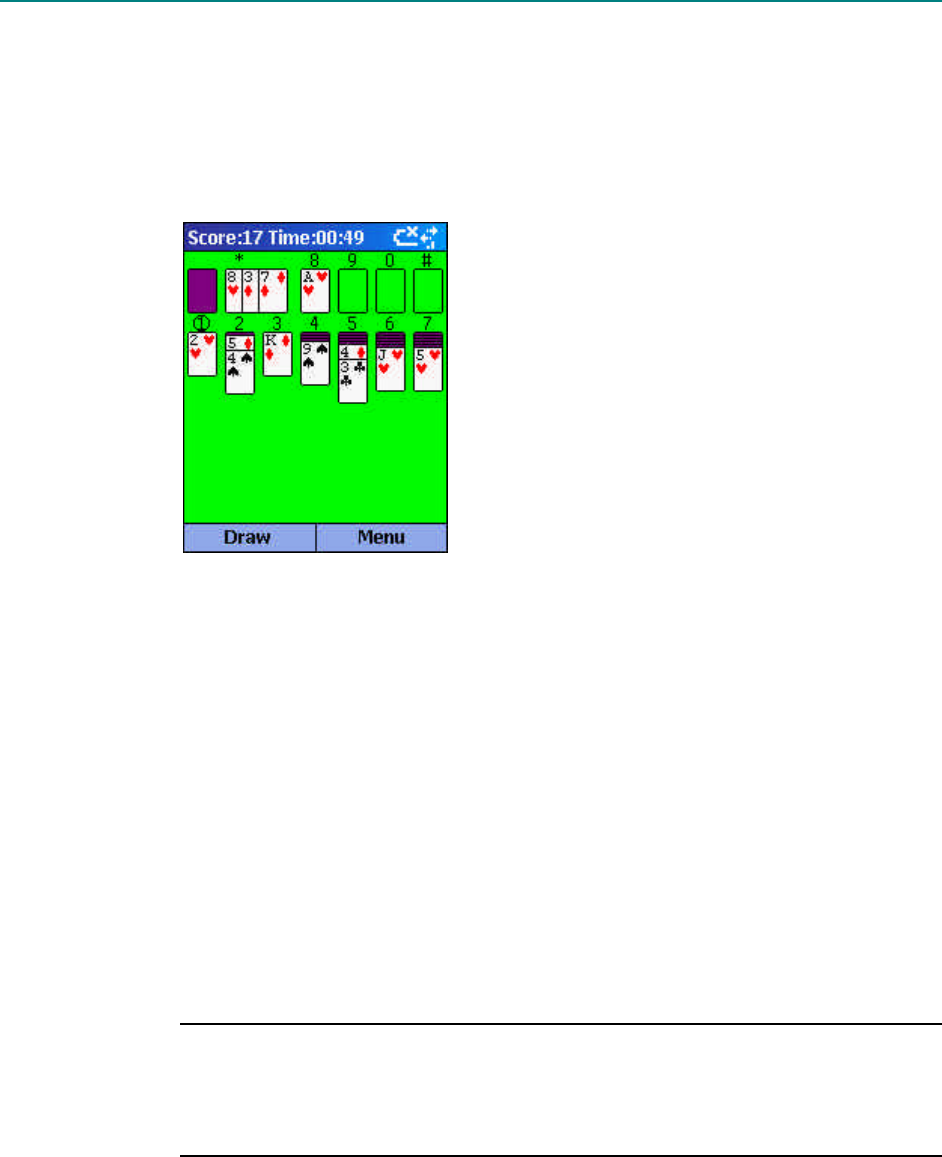
Internet, Entertainment, and More
85
Solitaire
The object of Solitaire is to use all the cards in the deck to build up the four
suit stacks in ascending order, beginning with the aces. You win the game
when all cards are on the suit stacks.
Figure 40 Solitaire
4 To start a game of Solitaire
§ On the Home screen, press the Programs soft key, select More, select
Games, select Solitaire, and then press the Action button.
Playing Solitaire
4 To start a new game of Solitaire
§ In Solitaire, press the Menu soft key, and then select New Game.
4 To move cards in Solitaire
§ Press the number or character above the card stack displaying the card you
want to move, and then press the number or character above the card stack
to which you want to move the card.
Tip: Pressing Up will move a card to one of the four card stacks on the
upper right corner of the screen if it belongs there. For example, if you have
an ace displayed in one of the seven stacks, press the number above the ace,
and then press Up.
4 To play Solitaire
1. Move any aces on the seven stacks to the four card spaces at the top of the
screen, and then make any other available plays.
2. When you have made all available plays, press the Draw soft key to turn
over cards.
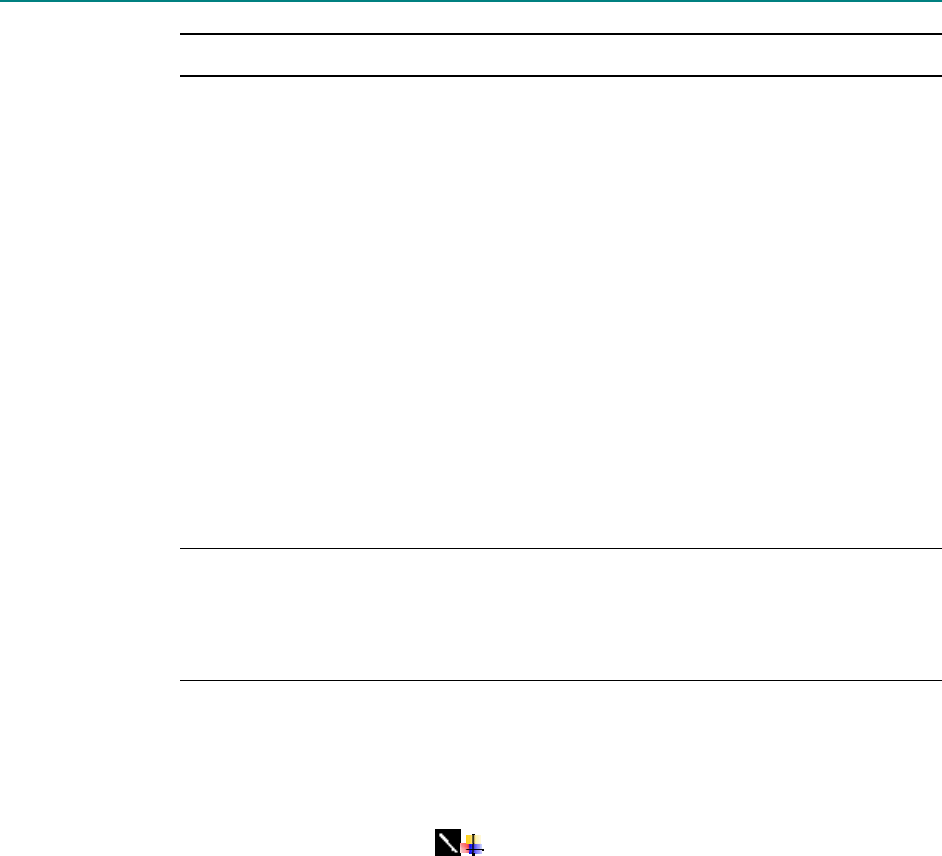
Windows® Powered Smartphone User’s Guide
86
Note: The card that is face up on the deck is always available for play.
Calculator
You can use Calculator to perform any of the standard operations for which
you would normally use a handheld calculator. Calculator performs basic
arithmetic, such as addition, subtraction, multiplication, and division.
4 To open Calculator
§ On the Home screen, press the Programs soft key, select More, select
Accessories, select Calculator, and then press the Action button.
4 To enter numbers and perform calculations
§ Use the keypad to enter numbers and perform calculations.
§ Press the Pound (#) key to cycle through the available mathematical
symbols, and press the Asterisk (*) key to enter a decimal point.
Tip: You can also use the direction keys to display the available
mathematical symbols. Press Up for the plus sign (+), press Down for the
minus sign (–), press Left for the division sign (/), and press Right for the
multiplication sign (X).
4 To clear the current calculation or displayed number
§ Press the Clear soft key.
4 To clear the last digit entered in a multiple-digit entry
§ Press the Back button.

Windows® Powered Smartphone User’s Guide
87
Appendix I
Care and Maintenance
§ Do not attempt to disassemble the phone.
§ Do not place the phone in direct sunlight or in humid, dusty or hazardous
areas.
§ Keep the phone dry. Precipitation, humidity and liquids containing
minerals will corrode the electronic circuit.
§ Do not subject the phone to irregular temperature. High temperature can
shorten the life of electronic devices, damage batteries and potentially
melt certain plastics. Moisture could form inside the phone and damage
the electronic circuits at an unstable environment.
§ Do not shock, drop or knock the phone as it could damage the internal
circuits.
§ Avoid contact with liquids. If the phone becomes wet, remove the
batteries immediately and contact your local service center.
§ Do not use harsh chemicals, cleaning solvents or strong detergents to clean
the phone. Wipe it with a soft cloth dampened with a mild cleaner.
If the phone or any of its accessories are not functioning properly. Refer to
your mobile phone manual first to check for correct usage. If it is indeed a
hardware malfunction, take the phone to your nearest authorized service
center and arrange for the phone to be repaired.